
Sea Surgeon's Dispensatory: 1 2 3 4 5 6 7 8 9 10 11 12 13 14 15 16 17 18 19 20 21 22 23 24 25 Next>>
The Sea Surgeon's Dispensatory, Page 16
Simples: Plants
Radix Raphani Sylvestris (Horseradish Root)
Listed in: Woodall: Radices Raphani Silvestri1
Category: Simple - Plant
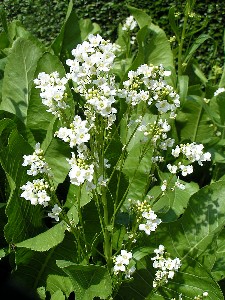
Photo: Wiki User Pethan
Horseradish (Armoracia Rusticana)
Humoral Property: dry2; hot [califie]3; "hotte in the third degree, drie in the second"4
Description: "Radices raphani silvestris or Horse redish roots ...[are] good for the stomake, eaten before meate causeth winde, and desire to vomit, but after meat [a meal] digesteth, purgeth flegme [phlegm, one of the bodily humors], provoketh urine, breaketh the [kidney] stone, helpeth the dropsie [edema], liver, sicknesse, old cough, stopping of the reynes [kidneys], lithargie [lethargy], chollicke, and hardnesse of the spleene, stayeth fretting, and festring ulcers, causeth haire to grow, and clenseth the face from spots."5
"Instit. Raphanus sylvestris, Offic. ...Horse Rhadish. It grows wild in several Places, near River Sides, and is planted in Gardens for the Sake of the Root, which is only used. It is heating, drying aperitive [opening], and frequently used in Sauces to create an Appetite. It is of great Use against the Scurvy, Dropsy and Jaundice, and often put into Diet Drinks for those Purposes. ...
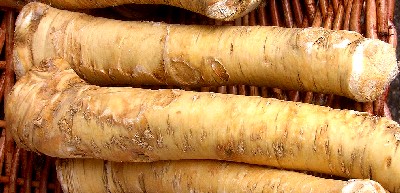
Photo: Anna Reg - Horseradish Roots
This Root, taken in a large Quantity, excites Vomiting. The Juice drank to the Quantity of two Ounces, it is good for those who are afflicted with pituitous Sordes [unclean mucus] in the Stomach, and if this be attended with Vomiting, it will be proper to drink plentifully of warm Water after taking the Dose. ...It is used for Gargarisms, in Putrefactions of the Gums, and yields a noble Spirit and Tincture. It is used externally in Sinapisms [a type of mustard plaster], and is an Ingredient in the Aqua Raphani composita."6
1 John Woodall, the surgions mate, 1617, p. 121; 2 Nicholas Culpeper, Pharmacopœia Londinesis, 1720, p. 11; 3 Jean de Renou, A Medicinal Dispensatory, 1657, p. 308; 4,5 Woodall, p. 121;6 Robert James, Pharmacopoeia Universalis, 1747, p. 296
Radix Rhabarbarum (Rhubarb Root)
Listed in: Tweedy: Rad. Rhei Pulv.1
Category: Simple - Plant
Humoral Property: "hot in the first degree, and drie in the second"2
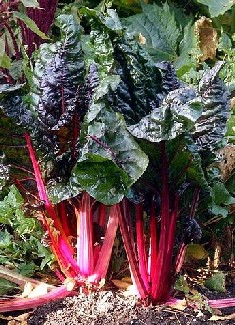
Photo: Anders Sanders - Rhubarb
Description: "Rhabarbari, Rhubarb. This is brought to use from several Parts; that which comes from the Levant is now accounted best. It is of a bright yellowish Colour, and of a Nutmeg Grain if it be good, tho a great deal of the best Pieces will be decay'd; and therefore when brought into use, ought to be rejected. There is some comes from China, and other parts of the East-Indies, but not so much esteem'd. ...That which is accounted the finest of all, is very little purgative, but is much preferable in all Intentions of a Restringent [medicine to draw tissues together], and therefore is best in Fluxes of all kinds. ...Extreme drying destroys its purgative Virtue, wherefore it is frequently order'd to be roasted on purpose to make it less purgative and more astringing [able to contract the body's tissues]. ...It greatly strengthens the Stomach and Bowels, and is an excellent Medicine against Cholor [yellow bile, one of the bodily humors], and other distemper'd Contents of the intestinal and mesenterial Glands [the mesentery is a fold of tissue that attaches organs to the body wall]. It is accounted by some to be a great purger of the Liver. The Kidneys do not lie too remote for its Influences... It is therefore good in Obstructions of the Reins [kidneys] and Uretors [ureters - tubes that propel urine from the kidneys to the bladder]. But in the Jaundice it almost passes for infallible."3
root_Rhei_radix_Rillke.jpg)
Photo: Wiki User Rillke - Dried Rhubarb Root
"Rhabarbarum ... True Rhubarb. As much as Rhubarb is used, as efficacious as it is found in Medicine, and as large a Part of Commerce as it maintains, yet are we very little acquainted as to what it is, and the real Place from whence it originally comes. ...The true Rhubarb first puts out large downy Leaves, then small Carnation-flowers in the Form of Stars, and after this comes the Seed. The Root newly drawn from the Earth is thick, fibrous, and blackish on the Surface, and of a red marble Colour within; when dried, it changes Colour, and becomes yellow without, and of a Nutmeg Colour within. It ought to be chose new, in small compact Pieces pretty solid and ponderous [heavy], of an astringent [sharp] Taste, somewhat bitter, and of an agreeable aromatic Odour. When good, it will tinge Water almost like Saffron, and when broke, it appears of a lively Colour, inclining a little to Vermillion."4
1 "158. John Tweedy's Bill for Medicines. November 8, 1743". Privateering and Piracy in the Colonial Period Illustrative Documents, John Franklin Jameson, ed., p. 459; 2 John Woodall, the surgions mate, 1617, p. 94; 3 John Quincy, Pharmacopoeia Officinalis & Extemporanea, 1719, p. 184-5; 4 Robert James, Pharmacopoeia Universalis, 1747, p. 417-8
Radix Sarasaparilla
Listed in: Tweedy: Rad. Sarsaparil.1
Category: Simple - Plant
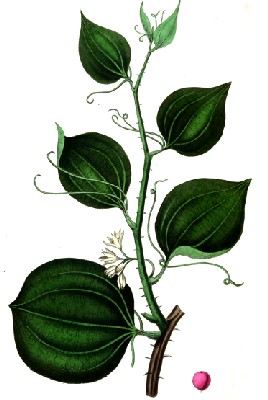
Sarsaparilla Smilax, From Medicinal Plants of the
London,
Edinburgh and Dublin Pharmacopoeias, Vol. 3 (1837)
Humoral Property: hot2; somewhat hot and dry3; heats [calefies] moderately4
Description: "Sarsaparilla ...causes sweat, especially extinguisheth the heat of venereal poyson, and is good for the articular diseases [diseases of the joints], catarrhs [excessive build up of mucus in the nose and throat], ulcers and phlegmatic [yellow bile-based] humors; principally it is good against the French Pox."5
"Sarsaparillæ, Sarsa, or Sarsaparill. This comes from the West-Indies. ...That is most in Esteem now, which is whitest within, and lightest, but not so dry as to run into Powder like what is rotten. It is accounted absorbent, and a great Sweetner, and much in Esteem and Use with some for a kind of Tea, which they constantly make with it, and drink with or without Milk, like the common Teas. Some much question whether there be really any medicinal Virtues in this Root, as it discovers [reveals] little in Taste, Smell or Tincture; and suspect it to have got into Esteem only, as many other things have done of very little worth, by their bearing a good Price, and being brought a great way. ...It is but in few of the [apothecary] Shop-Compositions [compound medicines], and consequently a very good Commodity amongst Druggists6."7
1 "158. John Tweedy's Bill for Medicines. November 8, 1743". Privateering and Piracy in the Colonial Period Illustrative Documents, John Franklin Jameson, ed., p. 459; 2 Thomas Brugis, The Marrow of Physick, 1669, p. 145; 3 Nicholas Culpeper, Pharmacopœia Londinesis, 1720, p. 12; 4 Jean de Renou, A Medicinal Dispensatory, 1657, p. 289; 5 Brugis, p. 145; 6 This comment is interesting in that it draws a distinction between the apothecary shops and druggists, with druggists clearly being indicated as inferior. Quincy's statement suggests druggists (as he uses the term) were more in line with the quacks who sold tonics and similar medicines rather than those recommended by the Worshipful Society of Apothecaries. 7 John Quincy, Pharmacopoeia Officinalis & Extemporanea, 1719, p. 104-5
Radix Serpentia Virginiana (Virginian Snakeweed Root)
Listed in: Tweedy: Rad. Serpent. Virg.1
Category: Simple - Plant
Humoral Property: hot and dry2
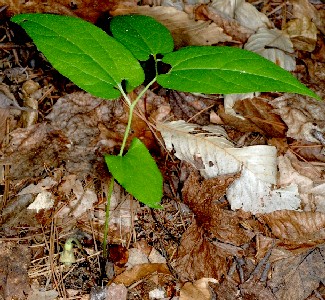
Photo: Doug Goldman - Virginia Snakeweed (Artistolochia serpentaria)
Description: "Serpentariæ, Snake-Weed. This is plentifully brought to us from Virginia and the West-Indies [note - Artistolochia serpentaria (Virginia Snakeweed) grows throughout the eastern United States but not in the West Indies. That plant is probably another variety such as Aristolochia odoratissima], and therefore has often its name in Prescriptions. It is very hot and pungent, both in Smell and Taste. The present extemporaneous Practice justifies it to be a powerful Alexipharmic [treatment for poison], and hardly ever omits it in most kind of Fevers, especially the worse and more malignant sort. ...it seldom fails to raise a Diphoresis [sweat]. Its Warmth also occasions its Use frequently in nervous and paralytick Cases, which proceed from too much Rheum [running flows] and Humidity."3
"Serpentaria Virgiana... Virgian Snake Weed. It grows in Virginia, the Roots are used, which are alexapharmic. They cure the Bite of the mad Dog, and defend them from the Hydrophobia [hydrophobia - a fear of water - was said to be a consequence of mad dog bites], and are a certain, and immediate Remedy for the venemous Bite of the Rattle-Snake. It is given as a Diaphoretic [medicine to provoke sweating to purge bad humors] in the Small Pox, Measles, and to kill Worms. It is, also emmenagogue [stimulates blood flow in the pelvic area and uterus] and diuretic. The Dose is from ten Grains to a Dram."4
1 "158. John Tweedy's Bill for Medicines. November 8, 1743". Privateering and Piracy in the Colonial Period Illustrative Documents, John Franklin Jameson, ed., p. 460; 2,3 John Quincy, Pharmacopoeia Officinalis & Extemporanea, 1719, p. 170 - Note that Quincy only suggests it is hot and drying without ascribing these as humoral qualities.; 4 Robert James, Pharmacopoeia Universalis, 1747, p. 440
Resina (Pine Resin)
Listed in: Woodall: Resina1
Category: Simple - Plant
Humoral Property: hot2
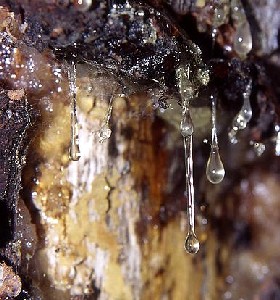
Photo: Wiki User Meanos - Pine Resin
Description: "Resina is ...mollifying [softening], discussing [matter dispersing] and cleansing, and being taken inwardly, it is good against the cough: mendeth the breast, provoketh urine, concocteth [combines] crude matters, looseth the belly, expelleth the [kidney] stone and gravells and is excellent for the cure of greene and fresh wounds."3
"Resina, Resin. These are all too well in the acquaintance of common People, to want any Description, or Account of their Production. And therefore we shall only observe, that they prove Ripeners or Drawers after a manner peculiar to all hard adhesive Bodies; which is by their sticking so close upon the Part affected, that they stop the Transpiration of the common perspirable Matter through the Sharf-Skin, or Cuticula. The Consquence of which is, that such comminuted [splintered] Matter returns with some degree of force, and ...will by degrees attenuate [reduce their force] and dislodge the obstructed Humours; whereby they either supperate into Matter [form pus], or are propelled through the true Skin; and for want of room, by means of the Plaster, to get further, they elevate the Cuticala from it into a Blister, and lie collected between both in the form of a thick Serum or Jelly. And this is the reason why such Substances apply'd to any part undistemper'd will often raise Blisters; as it is frequently practis'd to make Revulsions [counter-irritation], in some Pains of the head, Defluxions [flows], and sore inflamed Eyes. These are more or less in the Composition of most officinal Plasters, because they give a due Consistence, and are a kind of Cement to other Ingredients"4.
"Resin is, according to some Authors, a Gum discharged from the Turpentine Tree, the Larch Tree, the Mastich Tree, or the Cypress: But the Opinion of others is far more probably, who from Experience assert that it is Galipot [clear sap which flows from pine trees], boiled to a certain Consistence, and reduced to a Mass of any determinate Weight. The best Resin comes from Bayonne and Bourdeaux [France]. It ought to be chosen dry-white, free from Water and Sand."5
1,2,3 John Woodall, the surgions mate, 1617, p. 108; 4 John Quincy, Pharmacopoeia Officinalis & Extemporanea, 1719, p. 127; 5 Robert James, Pharmacopoeia Universalis, 1747, p. 405-6
Rhubarb
Listed in: Woodal-Chest: Rhabarbarum1, Moyle: Rubarb2
Category: Simple - Plant
Humoral Property: "hot in the first degree, and drie in the second"3
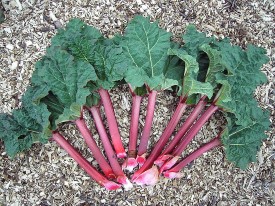
Photo: Dieter Weber - Rhubarb, Rheum Rhabarbarum
Description: "Rhabarbarum or Ruberbe is, of an astringent [drawing together] nature, and is good for the stomake, and liver, and against the bloudy flixe [bloody flux], purgeth downward chollericke [yellow bile] humors, and therefore very profitably used against hot fevers, inflammations, and stoppings of the liver &c. {1 ounce} is the full dosse."4
"Rhabarbarum ... True Rhubarb. The true Rhubarb first puts out large downy Leaves, then small Carnation-flowers in the Form of Stars, and after this comes the Seed. The Root newly drawn from the Earth is thick, fibrous, and blackish on the Surface, and of a red marble Colour within; when dried, it changes Colour, and becomes yellow without, and of a Nutmeg Colour within. It ought to be chose new, in small compact Pieces pretty solid and ponderous [heavy], of an astringent Taste, somewhat bitter, and of an agreeable aromatic Odour. When good, it will tinge Water almost like Saffron, and when broke, it apperas of a lively Colour, inclining a little to Vermillion."5
1 John Woodall, the surgions mate, 1617, p. 94; 2 John Moyle, The Sea Chirurgeon, 1693, p. 33; 3,4 Woodall, p. 94; 5 Robert James, Pharmacopoeia Universalis, 1747, p. 417-8
Ribeslæ (Currants)
Listed in: Woodall: Unæ passa1
Category: Simple - Plant
Humoral Property: cool2; cool [refrigerates] and dry [siccates] moderately3; cold and moist4; "hot in the first degree, or rather of a temperate qualitie"5
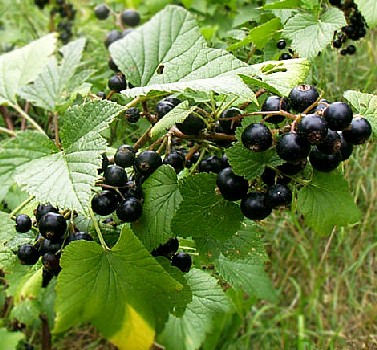
Black Currants (Ribes nigrum)
Description: "Unæ passa sen Corinthiacæ, or currans, ...by a speciall facultie they have, they prevaile against the vices of the breast, and liver: move, and purge the belly: strengthen the stomacke: purge the head: lenifie [soften/alleviate] and clense the breast and lungs."6
"Currant-bush in Latin Ribres. Currants ...provoke Appetit, allay the Heat of the Stomach, quench Thirst; and therefore are good Fevers. They temper the Heat of the Liver, and Choler; and resist Putrefaction [decomposition]."7
"Ribeslæ, Currants. These are of many sorts, but the red and white only are in use, unless for some very singular Purposes. For the black, and chiefly the Leaves upon first coming out, are us'd by some to flavour English Spirits, and counterfeit French Brandy. The red and white are very agreeably acid, and accounted wholesom Fruits as any we have of our own Growth. They greatly assuage Drought, cool and fortify the Stomach, and help Digestion. They may indeed be eat in too great quantities, otherwise no Harm can be receiv'd from them."8
1 John Woodall, the surgions mate, 1617, p. 102; 2 Nicholas Culpeper, Pharmacopœia Londinesis, 1720, p. 42; 3 Jean de Renou, A Medicinal Dispensatory, 1657, p. 386; 4 John Pechey, The Compleat Herbal of Physical Plants, 1707, p. 67; 5,6 Woodall, p. 102; 7 Pechey, p. 67; 8 John Quincy, Pharmacopoeia Officinalis & Extemporanea, 1719, p. 211
Rosemarium (Rosemary)
Listed in: Woodall: Rosemarie1
Category: Simple - Plant
Humoral Property: hot and dry in the second degree2; hot & dry in the 2nd degree3; hot [calefactive]4; "hot and drie in the second degree"5
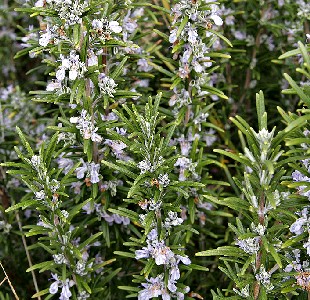
Photo: flagstaffotos - Rosemary Bush in Flower
Description: "Rosemarie ...cureth the Jaundice, and the Regius morbus or Kings-evill [scrofula, or struma, a tuberculous swelling of the lymph glands], comforteth the braine, memory, and inward senses, and restoreth the speech lost or broken."6
"Rosemary, in Latin, Rosmarinus. The Leaves, the Flowers and Seeds are in use: They are Cephalick [used to treat problems with the head], Uterine, and proper for the Nerves. They are chiefly used for Diseases of the Head and Nerves; for Apoplexies [unconsciousness caused by hemorrhage or stroke], Palsies, Falling-sickness [epilepsy], and Giddiness. They quicken [sharpen] the Sight, and help the Memory, and cure a Stinking-Breath. They are used for the Whites [vaginal discharges], and Jaundice. And they comfort the Heart, and open Obstructions of the Liver, Spleen and Womb. The Herb burnt, corrects the Air, and renders it wholesom in the time of a Plague."7
1 John Woodall, the surgions mate, 1617, p. 119; 2 Thomas Brugis, The Marrow of Physick, 1669, p. 153; 3 Nicholas Culpeper, Pharmacopœia Londinesis, 1720, p. 35; 4 Jean de Renou, A Medicinal Dispensatory, 1657, p. 340; 5,6 Woodall, p. 120; 7 John Pechey, The Compleat Herbal of Physical Plants, 1707, p. 205
Sabinæ (Savin or Juniper)
Listed in: Woodall: Sabina1
Category: Simple - Plant
Humoral Property: hot and dry in the third degree2; "hot and drie in the third degree"3
Photo: Réginald Hulhoven - Juniperus Sabina
Description: "Sabina Savin ...provoketh urine with bloud, moveth the flowers [causes menstruation], driveth forth the secondine [secundine - afterbirth], living and dead birth, cureth ulcers, and eating sores, and clenseth the skinne of Lentils."4
"Sabinæ, Savin. This Plant is an Ever-green. It is hot, attenuating [reduces the force of things], and very detergent [cleansing]; and so forcing upon the Womb, that it has got into the Practice of ill Persons to procure Abortion with it. It is a most powerful Cleanser, and therefore good in all Obstructions of the Viscera [internal organs], where a Constitution can bear its Efficacy. For the same reason it has obtain’d amongst Surgeons for cleansing old foul Ulcers. ...It is likewise esteem’d of great service against Worms; and its essential Oil, of which it affords good plenty, is frequently used for that purpose in outward Applications to the Belly."5
1 John Woodall, the surgions mate, 1617, p. 121; 2 Thomas Brugis, The Marrow of Physick, 1669, p. 153, Nicholas Culpeper, Pharmacopœia Londinesis, 1720, p. 36, Jean de Renou, A Medicinal Dispensatory, 1657, p. 339; 3,4 Woodall, p. 121; 5 John Quincy, Pharmacopoeia Officinalis & Extemporanea, 1719, p. 90-1
Saccharum (Sugar)
Listed in: Woodall: Saccharum1
Category: Simple - Plant
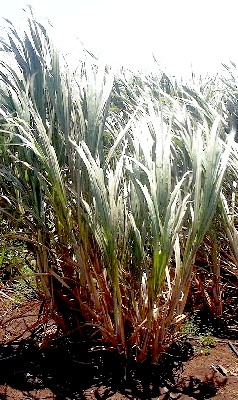
Photo: Forest & Kim Starr
Sugar Cane (Saccharum Officinarum)
Humoral Property: hot and dry in the second degree2; moderately hot3; "hot in the first degree"4
Description: "Saccharum, Sugar ... looseth the belly: is convenient to the stomacke, doth clense, digest, take away the asperitie, or ronghnesse of the tongue and siccitie [dryness], thirst, or drought in fevers: helpeth the reynes [kidneys], & bladder: and is profitable for eyes dim of sight."5
"Saccharum. Sugar. ...The Sugar Cane. Sugar is an artificial Concrete, prepared from the Juice of this Cane, by boiling it gently in Copper Vessels: this occasions the lighter Feculencies [dirt and other impurities] to rise to the Top, from whence they are carefully scummed off; while the more ponderous subside to the Bottom of the Vessel. The purified Syrup is then mixed with a due Portion of Lime Water, and gently boiled; which disposes it to granulate, or form saline Concretions. These are separated from the more liquid Parts by suitable Contrivances. By this means, the Juice of the Cane, is made to assume the Form of coarse Sugar: this is still further purified, by the Addition of Quick Lime, and repeated Coction [boiling]. When it is, by these means, brought to a due Consistence, it is poured out into conical earthen Moulds, having a Perforation at the smaller End, which is placed lowermost: through this Hole, the Molosses, or coarser Syrup, drains, while the purer Sugar is left behind, in a solid Mass, or Loaf....
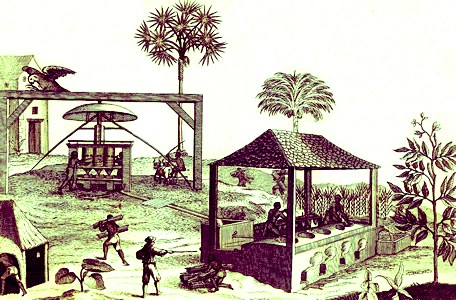
Sugar Production, From Histoire Generales des drogues,
simples
et
composeés by Pierre Pomet (1735)
Sugar, in some Degree, differs in medicinal Virtues according to its Degree of Fineness; thus the Muscovado, or Sugar first procured from the Cane, is more relaxing and purgative, and consequently more proper in Clysters [enemas], and cathartic [laxative] Syrups. The Cassonada, or Sugar once refin'd from the former, is something less relaxing, and more proper for internal Uses. The Loaf Sugar, or Cassonada still further refin'd, is said to be more detersive [cleansing]; they both cut Phlegm [one of the bodily humors], promote Expectoration [coughing up mucus from the lungs], and animate the Blood [another bodily humor]; but they excite Vapours and the Tooth-ach. They who use much Sugar are liable to Fevers, and to rotten Teeth."6
"It [sugar-cane] grows spontaneously in both the Indies. 'Tis also planted in many other places; as, in the Canary-Islands, Spain, Sicily, Crete and Cyprus. It loves a fat and moist Ground, and is fit to make Sugar in the space of a Year."7
1 John Woodall, the surgions mate, 1617, p. 102; 2 Thomas Brugis, The Marrow of Physick, 1669, p. 165; 3 Jean de Renou, A Medicinal Dispensatory, 1657, p. 224; 4,5 Woodall, p. 102; 6 Robert James, Pharmacopoeia Universalis, 1747, p. 424-5; 7 John Pechey, The Compleat Herbal of Physical Plants, 1707, p. 332
Sagapenum
Listed in: Woodall: Sagapenum1
Category: Simple - Plant
Humoral Property: "calefyes [heats] in the third, siccates [dries] in the second"2; "hot in the third degree, dry in the second"3

Ferulla Persica, Possible Source of Sagapenum
From Medicinal Plants of the London Edinburgh
and Dublin Pharmacopoeias ,Vol. 3 by John
Stephenson
& James Morss Churchill (1837)
Description: "Sagapenum, or Serapinum ...bringeth downe womens courses [cause menstruaion]: profitable against the suffocation of the Matrix [womb]: resolveth [reduces inflammation], attenuateth [reduces the force of things], dissipateth, moveth, dissolveth, and purgeth (though slowly) thicke fleame [plegm, one of the bodily humors], and clammie humors: it is esteemed excellent, if cleare, yellow in colour without, but white within: quicke in taste, light in substance, and easie in dissolving."4
"Sagapeni, Sagapenum. This is likewise the Tear or Gum of a Tree, and chiefly comes to use from Alexandria [Egypt]. That is reckon'd best, which is of a pungent Smell, somewhat resembling that of a Leek. This is also said to purge pituitous Humours from the Head and Stomach, and therefore to be good in all those Cases arising from thence. But it is much more met with in external Application."5
"Its concrete succe [solidified juice]... is only brought us [As opposed to the plant, which was not brought to Europe. Renou says of it, 'I neither yet saw nor read designed by any authour'.], the best whereof is translucid, yellow, white within, acrimonious [bitter], graveolent [having a fetid smell], and crass [unrefined] in substance."6
1 John Woodall, the surgions mate, 1617, p. 105; 2 Jean de Renou, A Medicinal Dispensatory, 1657, p. 401; 3,4 Woodall, p. 106; 5 John Quincy, Pharmacopoeia Officinalis & Extemporanea, 1719, p. 125; 6 Renou, p. 401
Salvæ (Sage)
Listed in: Woodall: Salvia1
Category: Simple - Plant
Humoral Property: hot in the 3rd degree and dry in the second2; hot in the second degree and dry in the third3; hot [califactive] and dry [siccative]4; "hot and drie in the third degree"5
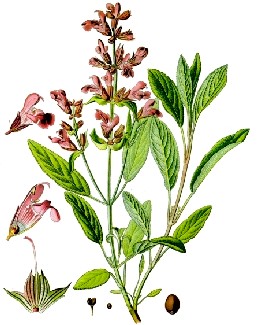
Artist: Franz Eugen Köhler
Sage, Salvia officinalis (1897)
Description: "Salvia Sage is ...somewhat astringent [contracts the body's tissues], stoppeth the bleedings of wounds and bloudie flixe [bloody flux], openeth the stoppings of the liver, cureth the cough, breaketh the [kidney] stone, provoketh urine, comforteth the heart, asswageth the head-ach, and paine in the side."6
"Salvæ, Sage: for the great esteem some have had of it, call'd Herba Sacra. It flowers in July and August. There are several sorts of this Plant; but there are only two in use. One is the Salvia major, or Latifolia, most in use in the [apothecary] Shops. This grows of two Colours, red and green. The former is prefer'd; tho the difference is but little. The other is the Minor, or Angustifolia, not used in the Shops, but much in private Families, under the Name of Sage of Virtue, and Tea-Sage. The latter has somewhat a more grateful Flavour in Tea, but the first is more efficacious, and therefore preferable in Medicine. ...It is undoubtedly a very good Cephalick [medicine for treating the head], of the detergent [cleansing] kind; and thereby it likewise comes under the Class of Vulneraries [wound healing medicines], Diureticks, &c. It has an Austerity upon the Palate, and makes a very good Gargarism, especially if sharpen'd with a little Acid."8
1 John Woodall, the surgions mate, 1617, p. 119; 2 Thomas Brugis, The Marrow of Physick, 1669, p. 153; 3 Nicholas Culpeper, Pharmacopœia Londinesis, 1720, p. 36; 4 Jean de Renou, A Medicinal Dispensatory, 1657, p. 321; 6,7 Woodall, p. 119; 8 John Quincy, Pharmacopoeia Officinalis & Extemporanea, 1719, p. 105
Sanguis Draconis (Dragon's Blood Resin)
Listed in: Woodall: Sanguis Draconis1
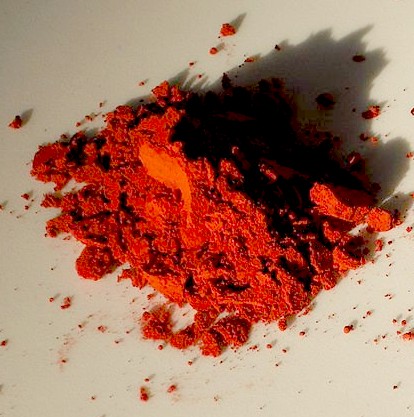
Photo: Andy Dingley - Powdered Dragon's Blood Resin
Category: Simple - Plant
Humoral Property: cools2; "colde and drie in the first degree"3
Description: "Sanguis Draconis ...is of an astringent [tissue shrinking] quality, it closeth up wounds, and confirmeth the weake parts, and stayeth the fluxes [flows] of outward wounds."3
"Sanguis Draconis. Dragon's-Blood. It is the Weepings of a Tree [Dracaena draco] which bears a Fruit not unlike a Cherry; the Skin of which is pull'd off, they say resembles a Dragon. It is experience'd to be of an agglutinating [adhesive] Quality, and is prescribed with success in most Fluxes and Hermorrhages. Its principle share in Composition is in the Lucatellus Balsam as some make it. 'Tis esteem'd a good Ingredient likewise in strengthening Plasters."5
"Dragon's-blood comes from one of the Canary-Islands, called Portus Sanctus, near the Madera's."5
1 John Woodall, the surgions mate, 1617, p. 109; 2 Nicholas Culpeper, Pharmacopœia Londinesis, 1720, p. 45; 3,4 Woodall, p. 109; 5 John Quincy, Pharmacopoeia Officinalis & Extemporanea, 1719, p. 97; 6 John Pechey, The Compleat Herbal of Physical Plants, 1707, p. 259
Santalum Rubrum (Red Sanders)
Listed in: Moyle: Santalum rubrum1
Category: Simple - Plant
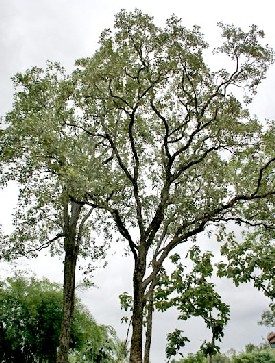
Photo: J. M. Garg - Red Sanders Tree
Humoral Property: "The Arabians, and most of the modern Physicians, hold, that Sanders are cold: But John Bauhinus [Swiss physician and botanist Johann Bauhin], and others, judge they are hot, by their Effects and Taste."2; "warm and drying"3
Description: "Santalorum omnium all the Saunders. There are three sorts in the [apothecary] Shops; the Citern or yellow, the White and the Red: The first is reckon'd the best, as it is the most aromatick; but the last, viz. the Red, most astringent [able to shrink tissue] and drying. They are in many of the Shop-Medicines [compound medicines], and sometimes used in Prescription amongst the Sweetners and Antiscorbuticks [medicines to fight scurvy], as they are call'd, and are in Diet-Drinks and medicated Ales."4
"[Sanders] are Epatick [probably hepatic - good medicines for the liver] and Cordial [good for the heart]. They are chiefly used for Fainting, Palpitation of the Heart, and Obstructions of the Liver. They are used outwardly in Epithems [topical medicines - plasters and ointments], for Catarrhs [excessive build up of mucus in the nose and throat], Headach, Vomiting, and for an hot Intemperies [disorders] of the Liver."5
1 John Moyle, The Sea Chirurgeon, 1693, p. 33; 2 John Pechey, The Compleat Herbal of Physical Plants, 1707, p. 327;3 John Quincy, Pharmacopoeia Officinalis & Extemporanea, 1719, p. 103;5 James Rennie, A New Supplement to the Pharmacopœpias of London, Edinburgh, Dublin and Paris, Baldwin and Cradock, 1833, p. 263; 6 Robert James, Pharmacopoeia Universalis, 1747, p. 270;
Sarsaparilla
Listed in: Woodall: Sarsaparilla1, Moyle: Sarsaparilla2
Category: Simple - Plant
Humoral Property: hot3; somewhat hot and dry4; "of a hot quality"5

Sarsaparilla Smilax, From Medicinal Plants of the
London,
Edinburgh and Dublin Pharmacopoeias, Vol. 3 (1837)
Description: "Sarsaparilla ...causeth sweat, especially extinguisheth the heat of venereous [venereal] poyson, and is
good for the articular [joint-related] diseases, ulcers, and phlegmaticke [yellow bile-based] humours, and principally it is good against the french pox [syphilis]."6
“There comes a certain long and uniform root from the Western Islands, especially from Peru, and the Province Hondouras, which is sometimes called Sarsaparilla, sometimes Salsaparilla, and Sarzaparaglia; which Matthiolus [16th century Italian physician Pietro Andrea Mattioli] and Dodonæus [Flemish physician and herbalist Rembert Dodoens] think to be the same with our Smilax [it is indeed a member of the same genus]: but they differ much, for Smilax root is nodous [knobby], and geniculated [bent at abrupt angles] like grass root, and much shorter and softer. Sarsaparilla’s root is without knots, aspirated [of a rough tdxture] with no genicles [knots], hard, fibrous, rugous [wrinkled], pithy, and sometimes twenty foot long, which may be easily cleft like a twig. Its other parts are like Smilax, and climbs vicine [nearby] Plants as Smilax doth.
Sarsaparilla calefies [heats] moderately, opens, projects sudour [sweat], and extinguishes the venerous poyson."7
1 John Woodall, the surgions mate, 1617, p. 97; 2 John Moyle, The Sea Chirurgeon, 1693, p. 33; 3 Thomas Brugis, The Marrow of Physick, 1669, p. 145; 4 Nicholas Culpeper, Pharmacopœia Londinesis, 1720, p. 12; 5 Woodall, p. 97; 6 Woodall, p. 97-8; 7 Jean de Renou, A Medicinal Dispensatory, 1657, p. 189
Sassafras
Listed in: Woodall: Sassafras1, Moyle: Sassaphras2
\Category: Simple - Plant
Humoral Property: hot and dry in the beginning of the 3rd degree3; "of a hot and drie temperament in the second degree"4
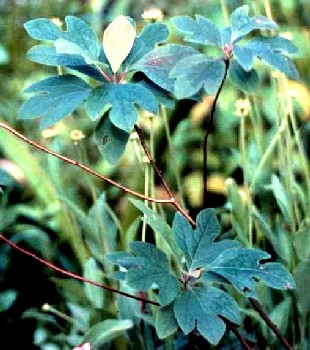
Photo: Larry Alain - Sassafras Albidum
Description: "Sassafras is ...commended in taking away obstructions, corroborating [strengthening] the inward parts, helping the Asthmatique [asthmatic], and Nephreticke [nephretic - people with kidney problems], clensing the reines [kidneys] from gravell, discussing winde, good for womens diseases, and against any kinde of fluxion [flux or flow], and the Morbus Gallicus, or French pox [syphilis] it is a good medicine."5
“A very grand tree grows in Florida, which the Indians call Pacame, the Spaniards, Sassafras, with a tall caul [stem], circumvested [surrounded] with a cintritous [ash colored] and thin bark, boughs expanded at the top, leaves like Fig leaves, dirempted [divided] into three angles, roots sometimes crass [thick], sometimes slender, according to the age of the tree, expanded along the interiour caverns of the earth, which are somewhat aromatical, smelling like Fennel.
The tree fruticates [sprouts] best in maritimous and temperate places [those warm and near the sea]; its root is best, and especially the bark thereof... Besides its elementary qualities, it is endued with peculiar ones, for which it is very expetible [desirable] and usefull ...the true Sassafras ...is of a fulve [amber] colour, and Fennel odour...
The decoctions of Sassafras, according to [Flemish physician and botanist Carolus] Clusius is good against all kinds of diseases, especially obstructions, womens diseases, and French pox; it roborates [strengthens] the internal parts."6
1 John Woodall, the surgions mate, 1617, p. 98; 2 John Moyle, The Sea Chirurgeon, 1693, p. 33; 3 Jean de Renou, A Medicinal Dispensatory, 1657, p. 287; 4,5 Woodall, p. 98; 6 Renou, p. 287-8
Scamonium (Scammony)
Listed in: Woodall-Chest: Scammonium1
Category: Simple - Plant
Humoral Property: hot and dry in the third degree2; " hot and drie in the second degree"3
Photo: Eitan F
Scammony - Convolvulus Scammonia
Description: "Scammonium ...purgeth downeward in vehement manner choleric [yellow bile-based] humors, and therefore is good against diseases arising from the same, but if it be taken either too much in quantity, out of time, place, or unprepared, it is very dangerous, excoriating the guts, provoking bloudy excrements, procuring Disenteria [Dysentery], causing winde, offending the stomacke, and distempering the heart and liver: the dose is eight graines."4
"This is the inspissated (thickened) Juice of a Root call’d by many Scammonium, of the Convolvulus kind. That which we have now in the [apothecary] Shops, must be different from Scammony of the Antients; because they gave it in much larger Doses, theirs being frequently a whole Dram, whereas ours cannot be trusted in the most robust, beyond a third of that quantity"5.
"The best comes from Antioch; 'tis clear, splendid, melts easily, and breaks easily, is not very weighty; being touched with the Tongue it grows milky, when it is broken 'tis yellowish; but that which we have commonly is of an Ash-colour, and looks ill, because it is not the Liquor or Tear flowing from the Plant, but the Juice press'd out."6
1 John Woodall, the surgions mate, 1617, p. 94; 2 Jean de Renou, A Medicinal Dispensatory, 1657, p. 264; 3,4 Woodall, p. 94; 8 John Quincy, Pharmacopoeia Officinalis & Extemporanea, 1719, p. 205-6; 6 John Pechey, The Compleat Herbal of Physical Plants, 1707, p. 330
Semen Anethi (Dill Seed)
Listed in: Woodall: Semen Anethi1
Category: Simple - Plant
Humoral Property: hot [calefies] and dry [siccates] in the second degree2; "hot and dry in 2d. degree"3
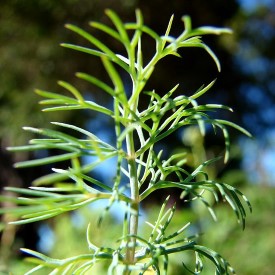
Photo: Forest and Kim Starr - Dill (Anethum Graveolens)
Description: "Semen Aniethi, or Dill seeds ... provoketh urine, allayeth against the griping [pains] of the belly, and inflations thereof: taketh away the Hicket [hiccups], increaseth milke, attenuateth [reduces the force of things], resolveth [elminates], and digesteth [break down] humors"4
"Dill, in Latin Anethum. 'Tis very like Fennel, yet it differs from it in many things: The Root is annual; the Stalk is less, and lower, for it is rarely three Foot high; the Leaves are lighter colour'd, and smell stronger, and not so pleasant, the Seed is broader, of an acrid Taste, and not so pleasant as that of Fennel; the Tufts of the Flower are yellow, but not so large. It grows in Gardens, and springs yearly from its Seed: But it grows no where spontaneously in England, as I know of.
The Herb, but especially the Seed, digests, discusses and ripens Tumours, increases Milk, disposes to Sleep, lessens Venery [sexual desire], cures Vomiting, and the Hickops. 'Tis said to be offensive to the Eyes; which seems strange to me, for that it is very like Fennel, both in Quality, and outward Appearance; and it expels also Wind: And Fennell is allow'd by all to be good for the Eyes."5
1 John Woodall, the surgions mate, 1617, p. 101; 2 Jean de Renou, A Medicinal Dispensatory, 1657, p. 332; 3,4 Woodall, p. 101;5 John Pechey, The Compleat Herbal of Physical Plants, 1707, p. 73
Semen Anisi (Aniseed)
Listed in: Woodall: Semen Anethi1
Category: Simple - Plant
Humoral Property: hot and dry2; hot [calefies] and dry [siccates] in the second degree3; "hotte and drie in the third degree"4
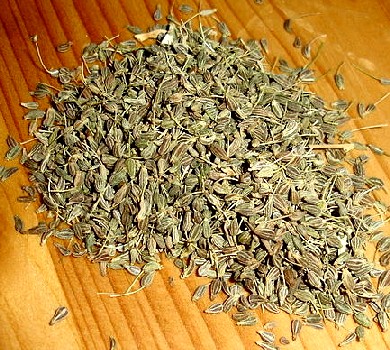
Photo: Mica - Anise Seeds
Description: "Semen anisi Anise seede ...doth discusse the windinesse of the stomake, and bowels: stoppeth the bloudy flixe [bloody flux], laske of the belly [looseness of the bowels], moveth urine, and monthly tearmes [menstruation], breaketh and bringeth away the [kidney] stone, helpeth obstructions of the liver, amendeth the breath, and is good for the falling sicknesse [epilepsy]."5
"Anise, in Latin Anisum. The Seed is chiefly used; the Herb it self but rarely; and the Root of it never. It heats, dries, is Cephalick [good for problems of the head], Epatick [probably hepatic - good for problems concerning the liver], Pnuemonick [good for problems of the lungs] and Stomachick. Tis used for Wind in the Stomach, a Cough, and the like. 'Tis more agreeable to the Stomach, than any other Medicine that is used to expel Wind; it has less Acrimony [bitterness], and is sweeter. The Antients [ancient physicians] extoll'd it wonderfully for a cold and moist Stomach; wherefore they used it in Pains of the Head proceeding from the Stomach, for Watchings [sleeplessness], and a Loosness occasion'd by Crudities. It provokes Urine, and stimulates Venery [sexual desire]. 'Tis baked with Bread, and candied, and so used. It expels Wind, and cures a Stinking Breath."6
1 John Woodall, the surgions mate, 1617, p. 99; 2 Nicholas Culpeper, Pharmacopœia Londinesis, 1720, p. 43; 3 Jean de Renou, A Medicinal Dispensatory, 1657, p. 336; 4,5 Woodall, p. 99; 6 John Pechey, The Compleat Herbal of Physical Plants, 1707, p. 210-1
Semen Cari (Caraway Seed)
Listed in: Woodall: Semen cari1, Moyle: Carraways Seeds (Carui)2
Category: Simple - Plant
Humoral Property: dry in the third degree3; hot4; "hotte and drie in the third degree"5
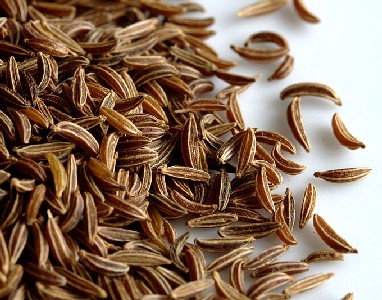
Photo: Wiki User Slick - Caraway 'Fruit'
Description: "Semen cari Caraway seede is of the same nature, and vertue as a Semen anisi [aniseed] aforesaid."6
(Woodall on aniseed: "Semen anisi Anise seede ...doth discusse the windinesse of the stomake, and bowels: stoppeth the bloudy flixe [bloody flux], laske of the belly [looseness of the bowels], moveth urine, and monthly tearmes [menstruation], breaketh and bringeth away the [kidney] stone, helpeth obstructions of the liver, amendeth the breath, and is good for the falling sicknesse [epilepsy]."7)
"Caraway, in Latin, Carum. It has a long, single Root, as thick as the Thumb, or thicker, and white. The Bulk of its increas'd by some Fibres that grow to it, which have an Aromatick Taste, and are somewhat acrid [bitter]. It has many Stalks three or four Foot high, channel'd smooth, solid and jointed and sometimes divided into Branches. The Leaves have a long Foot-stalk that is like the Keel of a Ship but 'tis narrow; they grow partly from the Root and partly from the Wings or the Branches; like Leaves of Wild-Carrot, but that bear their Wings at the greater distance. The Flowers are single, small, round, whitish, or reddish. The Seed is oblong, channel'd, and of an acrid and Aromatic Taste. It grows frequently in far, pleasant and green Fields, and in Meadows that are sometimes water'd.
The Seed is Stomachic [good for problems of the stomach] and Diuretick: it expels Wind, and helps Concoction [digestion or combination of food]; provokes Urine and strengthens the Brain. 'Tis of great Use in the Cholick, and for Giddiness in the Head and the like."8
1 John Woodall, the surgions mate, 1617, p. 100; 2 John Moyle, The Sea Chirurgeon, 1693, p. 33 3 Thomas Brugis, The Marrow of Physick, 1669, p. 160; 4 Jean de Renou, A Medicinal Dispensatory, 1657, p. 246; 5 Woodall, p. 99; 6 Woodall, p. 100; 7 Woodall, p. 99; 8 John Pechey, The Compleat Herbal of Physical Plants, 1707, p. 44
Semen Chichoreum (Chicory/Succory Seed)
Listed in: Woodall: Semina quatuor frigida minora (Cichory)1
Category: Simple - Plant
Humoral Property: cold2; "dry and cold in the third degree"3
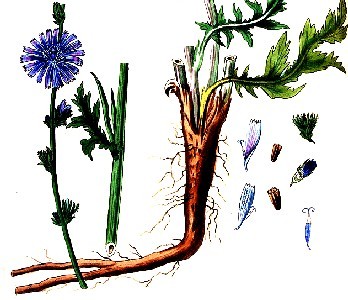
Artist: Janus Kops - Cichorium Intibus, From Flora Batava, v. 11 (1800)
Description: "Semina quatuor frigida minora, or the foure seeds, cold (to wit, Lactucæ, Portaluca Cichory, Endiviæ) ...refrigerateth the head, liver, spleene, reynes [kidneys], bladder, and limbs: prevaileth against the Gonorrhea, heate of the venerie [sexual desire]: moistneth, lenifieth [softens], slaketh thirst: and causeth sleep."4
"Cichorium, Ger. Garden Succory. It is planted in Gardens and flowers in June. The Root, Leaves, Flower and Seeds are used, its Seed is one of the four smaller cold Seeds. The ancient Botanic Writers generally affirm, the Succory is cold, but its Bitterness manifestly shows it to be hot; however it is aperitive [opening] and diuretic, opens Obstructions of the Liver, and is good for the Jaundice. It provokes Urine, and cleanses the urinary Parts of slimy Humour that may stop their Cavities."5
1 John Woodall, the surgions mate, 1617, p. 101; 2 Thomas Brugis, The Marrow of Physick, 1669, p. 160 & Nicholas Culpeper, Pharmacopœia Londinesis, 1720, p. 44; 3,4 Woodall, p. 101; 5 Robert James, Pharmacopoeia Universalis, 1747, p. 290
Semen Citrulli (Citrullus Seed)
Listed in: Woodall: Semena 4. frigida Majora (Curulli)1, Moyle: Quatour frigida major (Citrullus)2
Category: Simple - Plant
Humoral Property: cold3; "cold and moist in the second degree"4
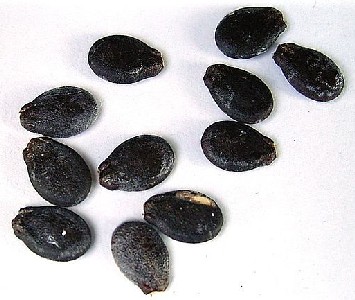
Photo: Frank Vincentz - Watermelon (Citrullus Lanatus) Seeds
Description: "The foure cold seedes, named Semina 4 frigida maiera (videlicet [viz.] Cucurbitæ, Cucumeris, Curulli, Melonis) [Curulli is] profitable to the stomacke, move[s] urine, helpe the ulcers of the reynes [kidneys], and bladder: and extinguisheth thirst, and choller [yellow bile, one of the bodily humors]"5
"Citrullus ...or Water Melon. It grows spontaneously in hot Climates, and though it is sown in more northern Countries, it never arrives at perfect Maturity. The fungous [fungus-like] Pulp or Marrow is a grateful Aliment not very nourishing, aqueous, but justly celebrated for its moistening, laxative, diuretic, and refrigerating Qualities. The Seeds are by Physicians classed among the four greater cold Seeds. They provoke Urine, but less powerfully than the Seeds of the Pompion [pumpkin]. They are principally used in cooling Emulsions."6
1 John Woodall, the surgions mate, 1617, p. 101; 2 John Moyle, The Sea Chirurgeon, 1693, p. 33; 3 Thomas Brugis, The Marrow of Physick, 1669, p. 160; 5 Nicholas Culpeper, Pharmacopœia Londinesis, 1720, p. 17; 3 Jean de Renou, A Medicinal Dispensatory, 1657, p. 259; 4,5 Woodall, p. 101; 6 Robert James, Pharmacopoeia Universalis, 1747, p. 293-4
Semen Cucubita (Gourd Seeds)
Listed in: Woodall: Semena 4. frigida Majora (Cucurbitæ)1, Moyle: Quatour frigida major (Curcubita)2
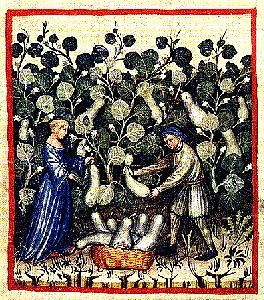
Squash (Cucurbite) From the Tacuinum of Vienna
Category: Simple - Plant
Humoral Property: cold3; cold and moist in the second degree4
Description: "The foure cold seedes, named Semina 4 frigida majera (videlicet [viz.] Cucurbitæ, Cucumeris, Curulli, Melonis) [Cucurbita] extinguisheth the fervour or heate of bloud [one of the bodily humors], choler [yellow bile, another bodily humor], and fevers."5
"Cucurbita, Offic. ...The Gourd. It grows in Gardens, tho's seldom, and flowers in July. The Seed, which is the only Part used, is one of the four greater cold Seeds, and allays Thirst, provokes Urine, and extingeshes Inclinations to Venery [sexual indulgence]."6
"Cucumer, Gourge [gourds - cucurbita], [Musk] Melon and Pompion [pumpkin], are called the four greater cold Seeds and are used in antinephritic [used to treat the kidneys], antiphrenetic, &c. [etc.] emulsions."7
1 John Woodall, the surgions mate, 1617, p. 101; 2 John Moyle, The Sea Chirurgeon, 1693, p. 33; 3 Thomas Brugis, The Marrow of Physick, 1669, p. 160;
4 "File:Tacuin Courge11.jpg", Squash (Cucurbite) From the Tacuinum of Vienna, wikimedia commons, gathered 6/11/15; 5 Woodall, p. 101; 6 Robert James, Pharmacopoeia Universalis, 1747, p. 305; 7 Brugis, p. 160
Semen Cucumber
Listed in: Woodall: Semena 4. frigida Majora (Cucumeris)1, Moyle: Quatour frigida major (Cucumer)2
Category: Simple - Plant
Humoral Property: cold3; cold and moist in the second degree4
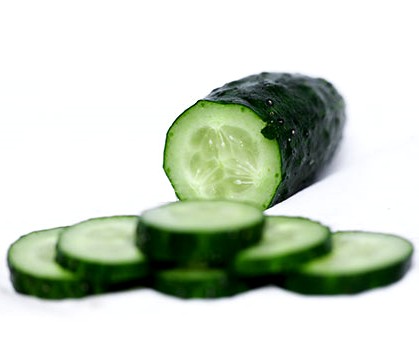
Photo: Mg Moscatello - Cucumber
Description:"The foure cold seedes, named Semina 4 frigida majera (videlicet [viz.] Cucurbitæ, Cucumeris, Curulli, Melonis) [Cucumeris is] profitable to the stomacke, move[s] urine, helpe the ulcers of the reynes [kidneys], and bladder: and extinguisheth thirst, and choller [yellow bile, one of the bodily humors]"5
"Cucumber, in Latin Cucumis. The Seed of it is one of the four greater cold Seeds. It cleanses, opens, and provokes Urine. 'Tis frequently used in Emulsions for Pleurisies [inflammation of the pleura – the membrane lining the cavity of the chest], and the Stone in the Kidneys."6
"Cucumis sativus vulagaris, ...Cucumber. This is common in Gardens, and flowers in June; the Fruit and Seed, which is one of the four greater cold Seeds are used; The seeds are esteem'd refrigerating [cooling], abstergent [purging], and opening; they provoke Urine, and are frequently used in antipleuritic and antinephritic [used in treating the kidneys] Emulsions."7
1 John Woodall, the surgions mate, 1617, p. 101; 2 John Moyle, The Sea Chirurgeon, 1693, p. 33; 3 Thomas Brugis, The Marrow of Physick, 1669, p. 160; 5 Nicholas Culpeper, Pharmacopœia Londinesis, 1720, p. 17; 3 Jean de Renou, A Medicinal Dispensatory, 1657, p. 259; 4,5 Woodall, p. 101; 6 John Pechey, The Compleat Herbal of Physical Plants, 1707, p. 66; 7 Robert James, Pharmacopoeia Universalis, 1747, p. 305
Semen Cumini (Cumin Seed)
Listed in: Woodall: Semen Cunimi1, Moyle: Quatuor. Callid. major (Cumini)2
Category: Simple - Plant
Humoral Property: hot3; hot and dry4; "hot, and drie in the third degree"5
Photo: Maša Sinreih - Cumini Fructus
Description: "Semen cumini Cummen seede ...attenuateth [reduces the force of], digesteth, resolveth, discusseth [disperses] winde, dissipateth phlegmaticke [yellow bile] humours, and is good against the chollicke and timpanie [swelling of the abdomen with gas]."6
"Cumin, in Latin Cuminum. The Seeds of it resolves [eliminates] and discusses [disperses] Wind; and therefore is a good in the Cholick, for a Tympany [swelling of the abdomen with gas] and a Vertigo. Taken in Sweet Wine, it relieves those that are afflicted with a Difficulty and a Heat of Urine. Boyl'd with Figs, in Wine, it cures a Cough, and cleanses the Breast. 'Tis conveniently baked with Bread, for it helps Concoction [digestion - combining of foods], and dissipates Wind. But the frequent use of it, in a large quantity, renders the Countenance Pale. It cures a Stinking Breath. ...'Tis sown in abundance in the Island of Melita [Malta]."7
1 John Woodall, the surgions mate, 1617, p. 100; 2 John Moyle, The Sea Chirurgeon, 1693, p. 33; 3 Thomas Brugis, The Marrow of Physick, 1669, p. 160; & Jean de Renou, A Medicinal Dispensatory, 1657, p. 246; 4 Nicholas Culpeper, Pharmacopœia Londinesis, 1720, p. 44; 5,6 Woodall, p. 100; 7 John Pechey, The Compleat Herbal of Physical Plants, 1707, p. 254-5
Semen Endiviæ (Endive Seed)
Listed in: Woodall:Semina quatuor frigida minora (Endiviæ)1
Category: Simple - Plant
Humoral Property: cold2; "dry and cold in the third degree"3
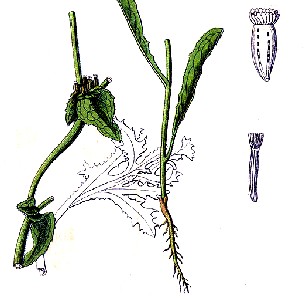
Artist: Johann Georg Sturm
Cichorium endiva, From Deutschlands Flora in
Abbildungen (1796)
Description: "Semina quatuor frigida minora, or the foure seeds, cold (to wit, Lactucæ, Portaluca Cichory, Endiviæ) ...refrigerateth the head, liver, spleene, reynes [kidneys], bladder, and limbs: prevaileth against the Gonorrhea, heate of the venerie [sexual desire]: moistneth, lenifieth [softens], slaketh thirst: and causeth sleep."4
"Cichorium latifolium, sive Endivia vulgaris... Endive. It grows in Gardens, flowers in June, and when the Seed is ripe the Root perishes. Endive is much used in Salads. It is cooling and moistening, opens Obstructions of the Liver and Spleen, is efficacious against the Jaundice, provokes Urine, and greatly cools a hot Stomach; its Seed is one of the lesser cold Seeds."5
"Endive, in Latin Endivia. The Root is fibrous, and full of MIlk. The long, broad leaves lie on the Earth, they are like the Leaves of Lettice; sometimes indented about the Edges. The Stalk is two or three Foot high, smooth, channel'd, empty, and has many Branches, and is crooked; being cut, it yields a Milk. The Flowers come from the Wings of the Leaves; they are like the Leaves of Wild-Succory. It grows in Gardens."6
1 John Woodall, the surgions mate, 1617, p. 101; 2 Thomas Brugis, The Marrow of Physick, 1669, p. 160 & Nicholas Culpeper, Pharmacopœia Londinesis, 1720, p. 44; 3 Woodall, p. 101; ,4 Woodall, p. 101-2; 5 Robert James, Pharmacopoeia Universalis, 1747, p. 290; 7 John Pechey, The Compleat Herbal of Physical Plants, 1707, p. 84
Semen Foeniculi (Fennel Seed)
Listed in: Woodall: Semen Fæniculi1,Moyle: Quatuor. Callid. major (Foeniculi)2
Category: Simple - Plant
Humoral Property: dry in the third degree3; hot [califies] in the second or beginning of the third degree4; "hot in the third degree, drie in the first"5
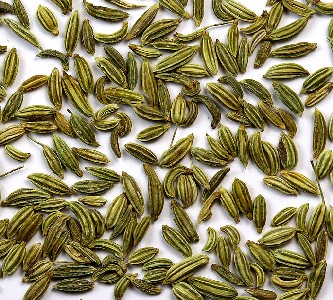
Photo: Sanjay Acharya - Fennel Seeds
Description: "Semen feniculi or fennill seede ...corroborateth the stomake, openeth
the obstructions of the lungs, liver, and kidnies, and causeth abundance of milke in womens breasts."6
"Fennel seed breaks wind, and provokes Urine and the terms [menstruation], encreaseth Milk in Nurses."7
"Common Fennel, in Latin Fæniculum vulgare. It grows on hot and stony Grounds; and in England on the Sea-banks, and on Chalk-hills; as in Cornwal, and in Pemsley-Marsh in Sussex. ...The seed strengthens the Stomach, and takes off Nauseousness: And being mix'd with Pectoral Medicines [medicines for the chest], it relieves those that are Asthmatick; and also resists Poyson."8
1 John Woodall, the surgions mate, 1617, p. 99; 2 John Moyle, The Sea Chirurgeon, 1693, p. 33; 3 Thomas Brugis, The Marrow of Physick, 1669, p. 161; 4 Jean de Renou, A Medicinal Dispensatory, 1657, p. 240; 4 Nicholas Culpeper, Pharmacopœia Londinesis, 1720, p. 44; 5 Woodall, p. 99; 6 Woodall, p. 99-100; 7 Culpeper, p. 44; 8 John Pechey, The Compleat Herbal of Physical Plants, 1707, p. 86-7
Semen Fœnugræci (Fenugreek Seed)
Listed in: Woodall: Semen Fenigræci1, Moyle: Farina Fenugreci2
Category: Simple - Plant
Humoral Property: hot in the second and dry in the first degree3; cool [refrigerative] or rather temperate4; "hot in the second, and drie in the third degree"5
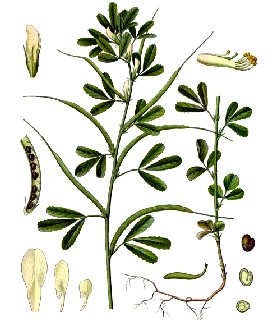
Artist: Franz Eugen Köhler
Fenugreek (Trigonella foenum-graecum) (1897)
Description: "Semen feigracæci or Fenigrece ... doth mollifie [soften], discusse [dissipate], and mundifie [cleanse]: helpeth cold, hard swellings, impostume [large abscesses], and Goute in the feete: wasteth, and lenifieth [soften] the hardnesse of the melt [spleen]: mittigateth heate: is profitable for the matrix [womb] in women, and clenseth the skinne from many evills, as itch, scurfe [flaking of the skin], pimples, wheales [small swellings on the skin], and the like."6
"Fenugreek, in Latin Fœnum Græcum. ...'Tis sown in many Places: I never found it grow Spontaneously.
The Flower of the Seed, which is only in use, mollifies, digests, ripens and discusses; and is Anodine [eliminates pain]: And the use of it is so very frequent, that there is scarce a Chirurgeon makes a Poultess [poultice] without it, or its Musilage. 'Tis also often used in Emollient [softening] Clysters; for the Musilaginous Substance, blunts the Acrimony of the Humours, and keeps the Guts from Erosion."7
1 John Woodall, the surgions mate, 1617, p. 100; 2 John Moyle, The Sea Chirurgeon, 1693, p. 33; 3 Thomas Brugis, The Marrow of Physick, 1669, p. 161; 4 Jean de Renou, A Medicinal Dispensatory, 1657, p. 364; 5,6 Woodall, p. 100; 7 John Pechey, The Compleat Herbal of Physical Plants, 1707, p. 87-8
Semen Lactucæ (Lettuce Seed)
Listed in: Woodall: Semina quatuor frigida minora (Lactucæ)1
Category: Simple - Plant
Humoral Property: cold2; "dry and cold in the third degree"3
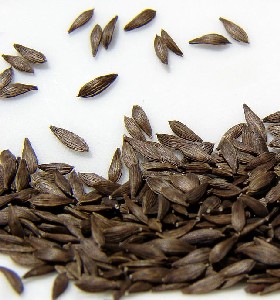
Photo: Forest and Kim Starr
Lettuce Seeds (Lactuca Sativa)
Description: "Semina quatuor frigida minora, or the foure seeds, cold (to wit, Lactucæ, Portaluca Cichory, Endiviæ) ...refrigerateth the head, liver, spleene, reynes [kidneys], bladder, and limbs: prevaileth against the Gonorrhea, heate of the venerie [sexual desire]: moistneth, lenifieth [softens], slaketh thirst: and causeth sleep."4
"Lactuca, Offic. Lactuca sativa. Boerh. Ind. A. Garden Lettuce. It is sown in Gardens, the Leaves and Seed are used. ...Lettuces in general are esteemed, emollient [softening], refrigerating [cooling], saponaceous [soapy], resolvent [removing], diuretic, and somewhat laxative; but are better raw than boil'd."5
"Garden-Lettice, in Latin Lactuca sativa. It cools the Stomach, and qualifies Choler [yellow bile, one of the bodily humors] and heat, and disposes to Rest, and increases Milk, and yields good Nourishment."6
1 John Woodall, the surgions mate, 1617, p. 101; 2 Thomas Brugis, The Marrow of Physick, 1669, p. 160 & Nicholas Culpeper, Pharmacopœia Londinesis, 1720, p. 44; 3,4 Woodall, p. 101; 5 Robert James, Pharmacopoeia Universalis, 1747, p. 351-2; 6 John Pechey, The Compleat Herbal of Physical Plants, 1707, p. 140
Semen Lini (Flaxseed)
Listed in: Woodall: Semen Lini1, Moyle: Farina Cem. Lini2
Category: Simple - Plant
Humoral Property: hot in the first degree3; "hot in the first degree, temperate in moisture and drinesse"4
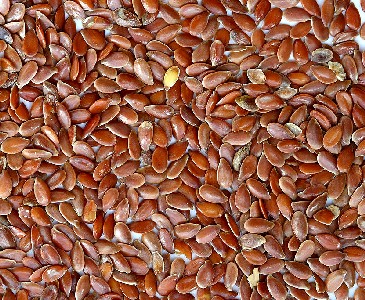
Photo: Sanjay Acharya - Brown Flax Seeds (Linum Usitatissimum)
Description: "Semen lini or Line seedes ... softneth all cold tumors, ripeneth, breaketh impostumes [large abcesses], draweth out thornes sticking in the body, expelleth winde, and gripings of the belly, and clenseth the flesh from spots."5
"Linum ...Flax. It is sown in Fields, flowering in June. The Seed is used, which is usually called Linseed, and is digesting [forms new flesh], emollient [softening], and ripening, and is principally recommended in Coughs, Pleurisies and Consumptions [tuberculosis]. Externally apply'd it ripen's Tumors, mitigates Pains, and expels the Fœtus."6
"Flax, in Latin Linum sativum. 'Tis sown in the Fields."7
Modern Uses: Flaxseed contains fiber which might help with constipation and it may be helpful to people with heart and blood vessel diseases. Note that this is not medical advice and the author is not a medical professional. Raw flaxseeds can contain potentially toxic compounds. Flaxseed and flaxseed oil seem to be tolerated in limited amounts. It is not recommended for use by pregnant women.8
1 John Woodall, the surgions mate, 1617, p. 100; 2 John Moyle, The Sea Chirurgeon, 1693, p. 33; 4 Thomas Brugis, The Marrow of Physick, 1669, p. 161; ,4,5 Woodall, p. 100; 6 Robert James, Pharmacopoeia Universalis, 1747, p. 359; 7 John Pechey, The Compleat Herbal of Physical Plants, 1707, p. 94; 8 Stephen Foster, "Flaxseed", www.nccih.nih.gov, gathered 2/17/23
Semen Melon (Muskmelon Seed)
Listed in: Woodall: Semena 4. frigida Majora (Melonis)1, Moyle: Quatour frigida major (Melon)2
Category: Simple - Plant
Humoral Property: cold3; cold and moist in the second degree4
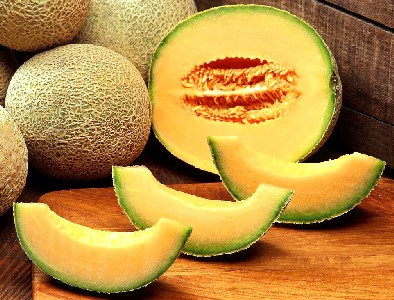
Musk Melon (Canaloupes)
Description:"The foure cold seedes, named Semina 4 frigida majera (videlicet [viz.] Cucurbitæ, Cucumeris, Curulli, Melonis) [Cucumeris is] profitable to the stomacke, move[s] urine, helpe the ulcers of the reynes [kidneys], and bladder: and extinguisheth thirst, and choller [yellow bile, one of the bodily humors]"5
"Melo, Offic. ...Musk Melon. It grows in Gardens, flowering in June. The Seed is used, which is one of the greater cold Seeds. It is esteem'd hepatic [good for treating the liver] and nephritic [used to treat the kidneys], good for Coughs, Consumptions [tuburculosis], and Fevers, and is serviceable in the Strangury [frequent, painful urination], and Heat of Urine, and to allay Thirst; in other Respects it agrees with the other greater cold Seeds."6
1 John Woodall, the surgions mate, 1617, p. 101; 2 John Moyle, The Sea Chirurgeon, 1693, p. 33; 3 Thomas Brugis, The Marrow of Physick, 1669, p. 160; 5 Nicholas Culpeper, Pharmacopœia Londinesis, 1720, p. 17; 3 Jean de Renou, A Medicinal Dispensatory, 1657, p. 259; 4,5 Woodall, p. 101; 6 Robert James, Pharmacopoeia Universalis, 1747, p. 370
Semen Papaveris Albi (White Poppy Seed)
Listed in: Woodall: Semen Papavaris Albi1
Category: Simple - Plant
Humoral Property: cold [refrigerative]2; "cold and dry in the fourth degree"3
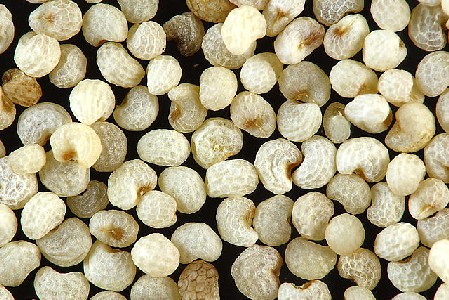
Photo: Sanjay Acharya - White Poppy Seeds
Description: "Semen papaveris albi, or white poppy seedes ...provoketh sleepe, taketh away subtill humors, catharres [excessive mucus buildup in the nose and throat], rheumes [running fluids] distilling from the braines upon the lungs: and helpeth the cough."4
"Poppy seeds, ease pains, and provokes sleep. Your best way is to make and Emulsion of 'em with Barley water."5
"Papever album... White Poppy. It is sown in Gardens, flowering in July; the Leaves, Flowers, heads and Seeds, together with the condensed Juice, called Opium, are used. The Herb, Heads, and Seeds refrigerate and moisten, and are principally used to promote Sleep, in Affections of the Breast, and Lungs, particularly in a Cough, Hoarseness, and Consumption [tuberculosis], but in the last I am afraid with very bad Effect. They also used in Fluxes of the Belly, and are excellent Ingredients in Fomentations, intended to mitigate Pain and induce Sleep. "6
1 John Woodall, the surgions mate, 1617, p. 101; 2 Jean de Renou, A Medicinal Dispensatory, 1657, p. 348; 3,4 Woodall, p. 101; 5 Nicholas Culpeper, Pharmacopœia Londinesis, 1720, p. 44; 6 Robert James, Pharmacopoeia Universalis, 1747, p. 395
Semen Petroselinum (Parsley Seed)
Listed in: Woodall: Semen Petroselini1
Category: Simple - Plant
Humoral Property: heats [calefies] and dries [siccates] noticably2; "hot in the second degree, and drie in the third"3
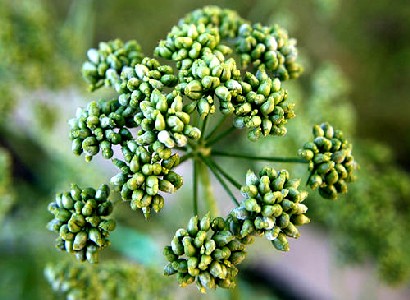
Photo: Wiki User Noumenon - Immature Parsley Seeds
Description: "Semen petroselini or Parsly seede ... is given to them that have the [kidney] stone, or jaundise, as also to provoke urine."4
"Parsly, in Latin Petroselinum. The Root and Herb expel Wind, provokes Urine and the Courses [menstruation], and open Obstructions of the Liver and Spleen, and are good in the Dropsie [edema] and Jaundice. The Seed is good for the same Diseases, and for an old Cough, and against Poyson."5
"Petroselinum vulgare... Parsley. It grows in Gardens, flowering in June. The Root, Herb and Seed are used. ...Parsley is attenuating [reduces the force of things], opening, detergent [cleansing], and diuretic, and is principally used in Obstructions of the Lungs, Liver, Kidneys, and gall Bladder."6
1 John Woodall, the surgions mate, 1617, p. 100; 2 Jean de Renou, A Medicinal Dispensatory, 1657, p. 337; 3,4 Woodall, p. 100; 8 John Quincy, Pharmacopoeia Officinalis & Extemporanea, 1719, p. 127; 6 John Pechey, The Compleat Herbal of Physical Plants, 1707, p. 202; 5 James Rennie, A New Supplement to the Pharmacopœpias of London, Edinburgh, Dublin and Paris, Baldwin and Cradock, 1833, p. 263; 6 Robert James, Pharmacopoeia Universalis, 1747, p. 270
Semen Plantaginis (Plantane Seed)
Listed in: Woodall: Semen Plantaginis1
Category: Simple - Plant
Humoral Property: cool2; "cold and dry in the second degree"3
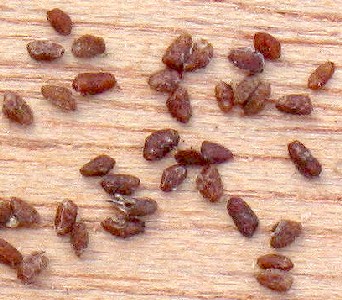
Photo: Wiki User Rasbak - Plantago Major Seeds
Description: "Semen Plantaginis, Plantane seeds ... stoppeth the flux of the belly, and any flux [flow] of bloud: and is good for Cararrhes [excessive mucus buildup in the nose and throat], old and new ulcers either of the body or mouth."4
"Plantain, in Latin Plantago. 'Tis a Vulnerary Herb [used to heal wounds]. 'Tis used in Fluxes of the Belly, for Spitting of Blood, Running of the Reins [kidneys], involuntary Urine, and for immoderate Fluxes of the Courses [menstruation]. 'Tis outwardly used to cleanse and heal Wounds and ulcers. ...Half a Dram of the Seeds taken daily in Broth, or in an Egg, is good to prevent Miscarriage."5
"Plantago vulgaris Septinervia ...Great Plantain. It grows by Way Sides. The Root, Leaves and Seed are used, which are heating and drying, hepatic [used to treat problems of the liver] and vulnerary, and are principally used in all Sorts of Fluxes."6
1 John Woodall, the surgions mate, 1617, p. 101; 2 Thomas Brugis, The Marrow of Physick, 1669, p. 160 & Nicholas Culpeper, Pharmacopœia Londinesis, 1720, p. 45; 3,4 Woodall, p. 101; 5 John Pechey, The Compleat Herbal of Physical Plants, 1707, p. 188; 6 Robert James, Pharmacopoeia Universalis, 1747, p. 407
Semen Portalacæ (Purslane Seed)
Listed in: Woodall: Semina quatuor frigida minora (Portaluca)1
Category: Simple - Plant
Humoral Property: cold2; cold and moist3; "dry and cold in the third degree"4
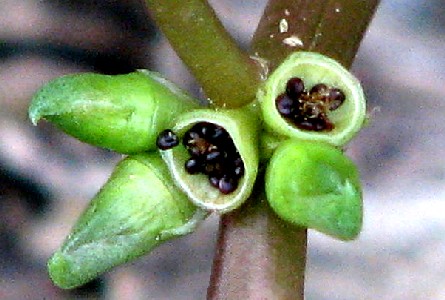
Photo: Wiki User 6th Happiness - Purslane Seed Pods (Portulaca Oleracea)
Description: "Semina quatuor frigida minora, or the foure seeds, cold (to wit, Lactucæ, Portaluca Cichory, Endiviæ) ...refrigerateth the head, liver, spleene, reynes [kidneys], bladder, and limbs: prevaileth against the Gonorrhea, heate of the venerie [sexual desire]: moistneth, lenifieth [softens], slaketh thirst: and causeth sleep."5
"Portulaca ...Purslane. It grows in Gardens, flowering in July. The Seeds are one of the four lesser cold Seeds. This Plant affords an excellent Aliment [nourishing food source] and Medicine; its Parts are very succulent; and the Juice astringent [contract the body's tissues], remarkably aperient [opening], expulsive [able to drive out], and cooling in inflammatory Diseases, and very good to wash the Gums, when affected with a Gangrene."6
"Purslain, in Latin Portulaca. It provokes Appetite. It cures Heat of Urine, and Running of the Reins."7
1 John Woodall, the surgions mate, 1617, p. 101; 2 Thomas Brugis, The Marrow of Physick, 1669, p. 160 & Nicholas Culpeper, Pharmacopœia Londinesis, 1720, p. 44; 3 John Pechey, The Compleat Herbal of Physical Plants, 1707, p. 196; 4,5 Woodall, p. 101; 5 Robert James, Pharmacopoeia Universalis, 1747, p. 410; 6 John Pechey, The Compleat Herbal of Physical Plants, 1707, p. 84; 7 Pechey, p. 196
Semen Sinapi (Mustard Seed)
Listed in: Tweedy: Sem. Sinapios1
Category: Simple - Plant
Humoral Property: hot and dry in the third degree2; hot3; hot and dry in the fourth degree4
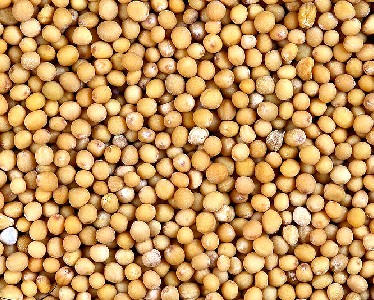
Photo: Sanjay Acharya - Yellow Mustard Seeds
Description: "Mustard... attenuates [reduces the force of things], draws, used chiefly to stir the appetite, in hypocondria's [problems of the abdomen], and quartan [recurring every three days] and quotidian [occuring daily] Fevers [these are usually malarial fevers], from tartarous mucilage, before the Fit, dose {1 dram} and in the [kidney] stone."5
"Mustard, in Latin Sinapi. It provokes Appetite; is good for Mother-fits [female hysteria], the Falling-sickness [epilepsie], Lethargy, Palsie, and all other Diseases of the Head, being put up the Nostrils, or applied in the manner of a Clyster [enema]. It provokes Urine, and the Courses [menstruation]; and is an Incentive to Venery [sexual desire]. It cures Catarrhs [excessive build up of mucus in the nose and throat], and removes Hoarsness. It loosens the Belly, and discusses Tumours. The Seed of it beat in a Mortar, and mix'd with White-wine, preserv'd the Lives of many Hundreds that were highly Scorbutical [suffering from scurvy], and in a languishing Condition, in a certain Town that was long besieg'd, and reduce'd to so great Want, that the Inhabitants were forc'd to eat nasty and unwholsom Things, whereby they became diseased; and many died before they thought of Mustard, which grew plentifully in the Town-Ditch; which being used as above-said, recover'd them all"6
1 "158. John Tweedy's Bill for Medicines. November 8, 1743". Privateering and Piracy in the Colonial Period Illustrative Documents, John Franklin Jameson, ed., p. 460; 2 Thomas Brugis, The Marrow of Physick, 1669, p. 161; 3 Nicholas Culpeper, Pharmacopœia Londinesis, 1720, p. 44; 4 Jean de Renou, A Medicinal Dispensatory, 1657, p. 293; 5 Brugis, p. 161-2; 6 John Pechey, The Compleat Herbal of Physical Plants, 1707, p. 165
Styracis (Styrax)
Listed in: Woodall: Styrax1
Category: Simple - Plant
Humoral Property: dry 2; hot and dry in the second degree3; hot [califies]4, "both hot in the second degree"5
Photo: Maria Jonker.
Collecting Styrax From Liquidambar Orientalis Trees
Description: "Styrax Calamita & liquidus ...both... doe mollifie, concoct, cure the cough, distillations, hoarsenes, pose or stuffing of the head, matrix [womb] stopped: are good to procure the monethly courses of women [menstruation], cordiall [good for the heart], exhilarating: opposite to poyson, and doe discusse [disperse] hard cold tumors, the knots of the sinewes, and the struma [swollen thyroid of the neck]. The best commeth from Ciprus [Cyprus], Sidon, and Pisidia: the Calamita Styrax is yellow, fast, rosen-like, in glistering fragments, persevering in smell, though old, and being dissolved of a hony-like colour, if commended."6
"Styrax (storax) balsam is a recent natural resin isolated from the wounded bark of Liquidambar orientalis Mill. (Asia Minor) and Liquidambar styraciflua L. (Central America) (Hamamelidaceae). It is often called benzoic resin, a similar resin obtained from the Styracaceae plant family."7
"Styracis, Storax. Of this there are two sorts in the Shops, the Storax Calamita, which is hard and gummy, and the Liquid Storax, of the Consistence of a thick Syrup, not much unlike the Peruvian Balsum. But the latter is very little us'd, being suspected to be factitious [artificially created], and not a natural Production. The former is both an excellent Pectoral [medicine for the chest] and Cephatick [medicine for the head]. It is of a very fragrant Scent, and looks of a reddish Colour, with some whitish Clouds. It is very subject to great mixtures of Dross, and not to be strain'd from them but with great difficulty; which occasions, that in many Compositions the coarse Lump is put in to be powder'd amongst the Species, instead of the strain'd Balsam, very much to the detriment of the Medicine. It mightily thickens and softens sharp Rheums [running fluids] [running flow from the nose and eyes], and cures the Coughs and Irritations thence arising. It is good almost in all Distempers of the Breast"8.
1 John Woodall, the surgions mate, 1617, p. 106; 2 Thomas Brugis, The Marrow of Physick, 1669, p. 164; 3 Nicholas Culpeper, Pharmacopœia Londinesis, 1720, p. 74; 5 Jean de Renou, A Medicinal Dispensatory, 1657, p. 386; 5 Woodall, p. 106; 6 Woodall, p. 106-7; 7 "Styrax balsam", wikipedia.com, gathered 8/13/15; 8 John Quincy, Pharmacopoeia Officinalis & Extemporanea, 1719, p. 119
Succus Absinthii (Absinth Juice)
Listed in: Woodall: Succus Absynthy1
Category: Simple - Plant
Humoral Property: hot and dry in the third degree2; hot and dry in the second or third degree3; "hot in the first degree and drie in the third"4
Photo: H. Zell - Absinthi Artemisia Absinthium
Description: "Succus Absinthy, juyce of wormewood is good for digestion: killeth the wormes: benefiteth the stomackes and differeth much from the vertues of the hearbe, this being astringent [drawing the body's tissues together], the other abstersive [cleansing or purging]."5
"Its recent express'd Juice drank in large Quantities, by irritating the Vessels, dissipating the Water, and attenuating [reducing the force of] the viscid Humours is of service in Dropsies [edemas] and Leucophlegmatias [Having a dropsical habit of body, with a white bloated skin], arising from Langous and Cold, that is, from a Redundance of Water or Phlegm [one of the four bodily humors]; but this Juice is no less injurious in that Species of Dropsy, which arised from a Dryness of the Liver or Spleen; since it augments the Force of the Circulation, Dryness, and Acrimony."6
1 John Woodall, the surgions mate, 1617, p. 88; 2 Thomas Brugis, The Marrow of Physick, 1669, p. 146; 3 Nicholas Culpeper, Pharmacopœia Londinesis, 1720, p. 17; 4 Woodall, p. 88; 5 Robert James, Pharmacopoeia Universalis, 1747, p. 202
Succus Acacia (Juice of Sloes)
Listed in: Woodall-Chest: Succus Acatiæ1
Category: Simple - Plant
Humoral Property: cold and dry in the third degree2
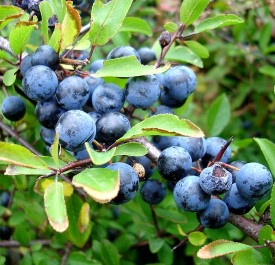
Sloes aka Blackthorn
Description: "Take of Sloes hardly ripe, press out the juice, & make it thick in a bath."3
Uses: "Succus Acatiæ is a forraine [foreign] medicine, for which wee use the juyce of Slowes: it doth refrigerate, binde, and repell: it stayeth all fluxes of the belly, healethe excoriations [abrasions] of the intralls, strengthneth much the stomacke: helpeth appetite, healeth ulcerations in the intralls, either used in Glisters [clysters - enemas], or eaten in a Gelly [jelly]. The dose whereof may safely be {1 ounce} at one time, or 2 {ounces} cannot offend: but I hold the infusion thereof, or the decoction of it to bee the aptest medicine, because of the grossness of the substance thereof."4
1 John Woodall, the surgions mate, 1617, p. 88; 2 Thomas Brugis, The Marrow of Physick, 1669, p. 164; 4 Woodall, p. 88; 3 Brugis, p. 107-8; 4 Woodall, p. 88
Succus Glycyrrhizzæ (Licorice Juice)
Listed in: Woodall-Chest: Succus Glycyrrhizzæ1 Tweedy: Succ. Glyzyrrhiz.2
Category: Simple - Plant
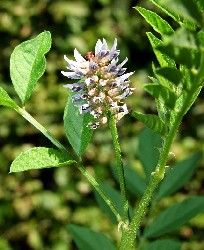
Photo: Pharaoh Han
Liquorice -
Glycyrrhiza Glabra
Inflorescence
Humoral Property: hot3; hot and moist4; "temperate in all qualities, but ascedes nearer to calour [heat]"5
Description: "Succus Glycerrhizæ, or juyce of Licorice in all his qualities is temperate, but exceeding in heate: somewhat it doth lenifie [assuage] the throat, & mitigate [reduce] the asperities [harshness] of the arteries: clenseth the bladder: and is good for the cough: moveth expectoration [phlegm in the throat and nose], and is very profitable against all vices of the lungs and throat."6
"The best that is grows in England; it is hot and moist in temperature"7.
1 John Woodall, the surgions mate, 1617, p. 88; 2 "158. John Tweedy's Bill for Medicines. November 8, 1743". Privateering and Piracy in the Colonial Period Illustrative Documents, John Franklin Jameson, ed., p. 459; 3 Thomas Brugis, The Marrow of Physick, 1669, p. 145; 4 Nicholas Culpeper, Pharmacopœia Londinesis, 1720, p. 8; 5 Jean de Renou, A Medicinal Dispensatory, 1657, p. 304; 6 Woodall, p. 88; 7 Nicholas Culpeper, Pharmacopœia Londinesis, 1720, p. 70
Succus Lymoniorum (Lemon Juice)
Listed in: Woodall-Chest: Succus Limonum1
Category: Simple - Plant
Humoral Property: cold [refrigerating]2; "refrigerating"3
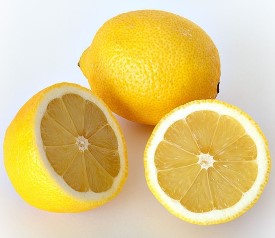
Photo: Andre Karwath - Lemons
Description: ""Succus Limonum, or juyce of Limons expelling and refrigerating, cleareth the skin of morphew [skin blemishes], killeth handwormes [Sarcoptes scabiei - an itch-insect]; and is of speciall use to bridle the heate of melancholie [black bile, one of the bodily humors]: to helpe sharpe and contagious fevers: is good to cause a pleasant taste in potions &c. and cordialls. It being very cordiall of it selfe, and the most pretious helpe that ever was discovered against the Scurvy to bee drunke at all times; for it mightily openeth all obstructions, and refresheth and restoreth nature."4
"The Lemon-Juice wonderfully astringes and hardens the Fibres in the Stomach, which makes it greatly assist it in Digestion: and there is hardly any one thing, which better enables it to retain its Food without any Regurgitation, after hearty eating."5
"Limon, in Latin Malus Limonia. Limons are more acide than Oranges or Citrons, and therefore it is probably the Juice is colder. ...The Juice of it is very proper to lessen the [kidney] Stone, and to cleanse the Urinary Passages."6
1 John Woodall, the surgions mate, 1617, p. 89; 2 Jean de Renou, A Medicinal Dispensatory, 1657, p. 372; 3,4 Woodall, p. 89; 5 John Quincy, Pharmacopoeia Officinalis & Extemporanea, 1719, p. 209; 6 John Pechey, The Compleat Herbal of Physical Plants, 1707, p. 299
Sumach
Listed in: Woodall: Sumach1
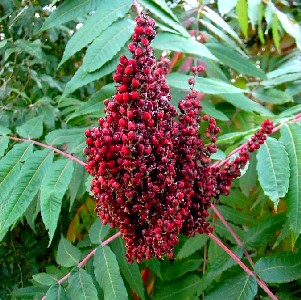
Photo: M.Readey - Sumac (Rhus) Berries
Category: Simple - Plant
Humoral Property: dry in the third degree and cold in the second2; "drie in the third degree, and colde in the second"3
Description: "Sumach is wonderfully astringent, ...it is good for the Dissentery [dysentery], all bloudy fluxes, and womens fluxes, especially the white [vaginal discharge], and the Hemorrhoides, preserveth also ulcers from inflammations and exulceration [soreness]."4
"Rhus Obsoniorum, Sumach ...Common Sumach. It is cultivated with us in the Gardens of the Curious, but grows spontaneously in Italy, Spain, and Turkey. The Part used is the Berries, which are refrigerating, drying, and astringent [draw tissues together]; good in all Kinds of Fluxes, whether of the Belly, Uterus, or Hæmorrhoids; externally applied it resists Putrefaction and a Gangrene."5
1 John Woodall, the surgions mate, 1617, p. 110; 2 Jean de Renou, A Medicinal Dispensatory, 1657, p. 367; 3,4 Woodall, p. 110; 8 John Quincy, Pharmacopoeia Officinalis & Extemporanea, 1719, p. 127; 6 John Pechey, The Compleat Herbal of Physical Plants, 1707, p. 202; 5 James Rennie, A New Supplement to the Pharmacopœpias of London, Edinburgh, Dublin and Paris, Baldwin and Cradock, 1833, p. 263; 6 Robert James, Pharmacopoeia Universalis, 1747, p. 270;
Tamarindi
Listed in: Tweedy: Tamarindae1
Category: Simple - Plant
Humoral Property: cold and dry in the second degree2; cold in the third degree and dry in the second3
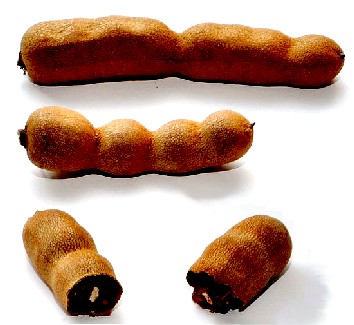
Photo: Wiki User Carschten - Tamarind Fruit (Tamarindus indica)
Description: "Tamarines, in Latin Tamarindi. They grow in Arabia Fælix, and in the East and West-Indies. They correct the Acrimony of the Humors, purge Choler [yellow bile, one of the bodily humors], and restrain the Heat of the Blood [another of the bodily humors]; they cure Fevers, and the Jaundice, and take off the Heat of the Stomach and Liver, and stop Vomiting. The Turks and Arabians, when they go long Journies in the Summer-time, carry Tamarinds with them, to quench their Thirst."4
"Tamarindi, Tamarinds. This is the Fruit of an Indian Tree of the Palm kind, and not greatly unlike the English Ash in manner of Growth. They are by some Writers called Indian Dates, and by others Indian Acacia. They come to us now from both, the Indies, and are either blackish or red. The latter are prefer'd. The Sailors are apt to enlarge their Bulk with too much Sugar, for a little does not hurt them. They are acid, pleasant, and cooling; and gently relax the Bowels."5
1 "158. John Tweedy's Bill for Medicines. November 8, 1743". Privateering and Piracy in the Colonial Period Illustrative Documents, John Franklin Jameson, ed., p. 458; 2 Nicholas Culpeper, Pharmacopœia Londinesis, 1720, p. 43; 3 Jean de Renou, A Medicinal Dispensatory, 1657, p. 254; 4 John Pechey, The Compleat Herbal of Physical Plants, 1707, p. 336; 5 John Quincy, Pharmacopoeia Officinalis & Extemporanea, 1719, p. 182
Terebinthina Common (Common Turpentine)
Listed in: Moyle: Tereb. Com.1
Category: Simple - Plant
Humoral Property: "all Rosines califie [heat] and siccate [dry]"2, very warm3
Photo: Walter Siegmund - Western Larch
Description: "Terebinthina,... Common Turpentine. This is procured from the Larch-Tree, a kind of Pine or Fir, which grows plentifully in many parts of Europe. Most of it comes to us from Venice and Strasburgh: the latter is most esteem'd, and is of a white greenish hue, transparent, and of the Consistence of a thick Syrup. The many purposes for which this is used in Medicine, can hardly be enumerated. It is a great Vulnerary [healing medicine], and very detergent [cleansing]; and therefore prescribed in all Suspicions of Abscesses and Ulcerations, in what part soever. It mightily assists Expectoration [coughing up of phlegm] in Diseases of the Lungs and Breast, and is therefore good in Asthma's and Pleurisies. But it most of all is famous for cleansing the Urinary Passages; and its Disposition to pass that way, is very manifest from its altering the Smell of the Water [urine], tho taken in ever so little a quantity, which it makes of a Violet Scent. Upon this account it is very good in all Obstructions of the Reins [kidneys], whether from Sand or any mucous Adhesions; and also in Gonorrhæa's which it wonderfully cleanses and heals, insomuch that there is scarce a Case of that kind now cured, which has not had some assistance from this Ingredient: tho in some Cases it may be over-done, as it is very warm, and upon that account will dispose the Testicles to Tumours and Inflammations, and likewise sometimes scour the Passages so much, as to make it difficult to bring them to their due Tensions and Capacities afterwards; whence arise Gleets [runny discharges] and involuntary Emissions. ...This is frequently in the Composition of Clysters against Cholicks, especially if they are suspected to proceed from the [kidney or urinary tract] Stone and Gravel... Its use in Chirurgery [surgery] is likewise very extensive, which see amongst the Topicks [topical medicines]."4
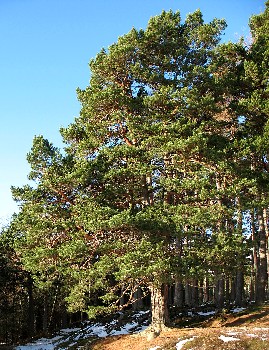
Pinus Sylvestrus (Scott's Pine)
Unlike John Quincy, physician Robert James says that common turpentine is different than Venice turpentine.
"Of this there are several Sorts, the first of which is the common Turpentine, produc'd by the Pinus sylvestris which see. Another Sort of Turpentine is the Venice Turpentine, a liquid substance of the Consistence of new Honey, of a yellowish Colour, and acrid and bitterish Taste, and a grateful and fragrant Smell. It is produc'd from the La[t]rix Offic. [larch] and is esteem'd heating, emollient [softening] and abstergent [detergent/cleansing]."5
It may be that these were distinct types of turpentine, or it may be that Venice (known for it production of turpentine) produced different types which included the common turpentine.
Physician John Pechey, says turpentine comes from "the Turpentine-tree [possibly referring to Pistacia terebinthus, a tree that grows in the Canary Islands used to make Cypress Turpentine], [a]nd the Latrix or Larch-tree. There are a great many of both sorts in hot Countries, such as Italy, Provence, and even Dauphine [both of which are in southeastern France]."6
1 John Moyle, The Sea Chirurgeon, 1693, p. 35; 2 Jean de Renou, A Medicinal Dispensatory, 1657, p. 259; 3,4 John Quincy, Pharmacopoeia Officinalis & Extemporanea, 1719, p. 127; 6 Robert James, Pharmacopoeia Universalis, 1747, p. 452
Terebinthina é Cypro (Cypress Turpentine)
Listed in: Moyle: Tereb. Cyperi1
Category: Simple - Plant
Humoral Property: "all Rosines califie [heat] and siccate [dry]"2
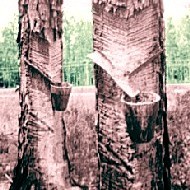
Turpentine Collection (1736)
Description: "Cypress and Chio Terebinth, good in coughs, and other affects of the lungs, with honey moves the belly and urine; 'tis to be wash'd, and so you may mix it with the yelk [yolk] of an egg first, and then dissolve in any proper liquor [liquid], or make it into Pills, being boil'd in some convenient liquor, and then poudred. The common is used almost in all Plasters."3
"Terebinthina é Cypro, Cyprus Turpentine. This differs from [common turpentine] not so much in its medicinal Efficacies as in Consistence, being thicker, and of somewhat more fragrant Scent. It has its Name from the Place it is principally brought from. It is more Astringing [able to draw the body's tissues together], and less Detersive [cleansing] than the common, and therefore more prescrib'd in Gleets [runny discharges], after there is no suspicion of Malignity remaining."4
1 John Moyle, The Sea Chirurgeon, 1693, p. 35; 2 Jean de Renou, A Medicinal Dispensatory, 1657, p. 259; 3 Thomas Brugis, The Marrow of Physick, 1669, p. 146; 4 John Quincy, Pharmacopoeia Officinalis & Extemporanea, 1719, p. 127
Terebinthina Venetiæ (Venice Turpentine)
Photo: Wiki User Antramir - Collecting Turpentine
Listed in: Woodall: Terebinth. Venetiæ1, Tweedy: Tereb. Venet.2
Category: Simple - Plant
Humoral Property: "all Rosines califie [heat] and siccate [dry]"3
Description: Woodall has nothing to say about Venice turpentine other than it is used in gunshot wounds. "Oyle of Terebinthine is very good; but Venice Terbinthine alone is much better"4.
"Procured from the abies larix. Resina liquida: Pini laricis. D. Has a strong unpleasant smell, and a hot, bitter taste. It is more liquid than the others, and is of a pale yellow."5
"[Turpentine is] good in coughs, and other affects of the lungs, with honey moves the belly and urine; ...The common [turpentine] is used almost in all Plasters."6
1 John Woodall, the surgions mate, 1617, p. 143; 2 "158. John Tweedy's Bill for Medicines. November 8, 1743". Privateering and Piracy in the Colonial Period Illustrative Documents, John Franklin Jameson, ed., p. 459; 3 Jean de Renou, A Medicinal Dispensatory, 1657, p. 259; 4 Woodall, p. 120; 5 James Rennie, A New Supplement to the Pharmacopœpias of London, Edinburgh, Dublin and Paris, Baldwin and Cradock, 1833, p. 437; 6 Thomas Brugis, The Marrow of Physick, 1669, p. 163
Thymum (Thyme)
Listed in: Woodall: Thymum1
Category: Simple - Plant
Humoral Property: hot and dry in the third degree2; "hot and drie in the third degree"3
Photo: Magnus Manske - Thyme (Thymus Vulgaris)
Description: "Thimum or Tyme ...is good to clense the brest, ripen fleame [phlegm, one of the bodily humors], and for the Asthma, purgeth chollericke [yellow bile] humours, corrupt bloud [another bodily humor], bringeth to women their naturall tearms [menstruation], expelleth the secondine [afterbirth], provoketh urine, discusseth winde, extenuateth [mitigates] colde swellings, and helpeth the cure of the falling sicknesse [epilepsy]."4
"Serpylli, Wild Thyme. It flowers in May. It is not much used... It is hot, pungent, and a Dryer.
Some commend it as a good Uterine, and say it promotes the Menses: And that it is very helpful in many Distempers of the Head, used in Baths.
"Thymi, Thyme. It flowers in July. It is much of the nature of Serpyllum, that in case of want they may be used for one another."5
1 John Woodall, the surgions mate, 1617, p. 120; 2 Thomas Brugis, The Marrow of Physick, 1669, p. 155 & Nicholas Culpeper, Pharmacopœia Londinesis, 1720, p. 39 & Jean de Renou, A Medicinal Dispensatory, 1657, p. 310; 3,4 Woodall, p. 120; 5 John Quincy, Pharmacopoeia Officinalis & Extemporanea, 1719, p. 81
Turbith
Listed in: Woodall: Turbith Cathapsaris1
Category: Simple - Plant
Humoral Property: hot in the third degree"2
Photo: Wiki User Daderot - Athamanta Turbith
Description: "Turpetum ...is good to purge phleame [phlegm, one of the bodily humors], chollericke [yellow bile, another bodily humor] and thicke humors from the stomake, breast, joints, and other remote parts, and helpeth the chollicke, and cold aches."4
"Turpethi, Turbith. It is not agreed, of what this is properly the Root: Some will have it of the Thlaspia... [others] the Scammony. It is much of the nature of Hermodactyl and Mechoacan, but more efficacious. It yields good store of resinous Particles to a spirituous Menstruum, which affect not much the larger Passages, but is very active and brisk in the smaller Vessels and glandulous Contortions, which it wonderfully clears of all viscid Adhesions. ...This is not much in extemporaneous Prescription [from the Latin 'ex tempore' ("at the time") - a prescription written on the spot for a specific patient with a specific ailment], but in pretty many of the official Compositions [compound medicines]; the Extractum Rudii particularly.... The Simple is hardly ever given alone: its Dose is from half a Dram to a Dram, in Powder; and from one Dram to half an Ounce, in Infusion; hardly ever given, but to grown Persons. Some commend it in obstinate scrobutick Cases [scurvy]; and even in the most aggravated Symptoms of the Venereal Distemper [syphilis]; but common Practice does not much own it in those Intentions."5
1 John Woodall, the surgions mate, 1617, p. 96; 2 Jean de Renou, A Medicinal Dispensatory, 1657, p. 81 & Woodall, p. 120; 4 Woodall, p. 120; 5 John Quincy, Pharmacopoeia Officinalis & Extemporanea, 1719, p. 185-6
Verjuice
Listed in: Woodall: Verjuice1, Tweedy: Verjus.2
Category: Simple - PlantHumoral Property: cold in the second degree3; colder4; "a good cooling medicine"5
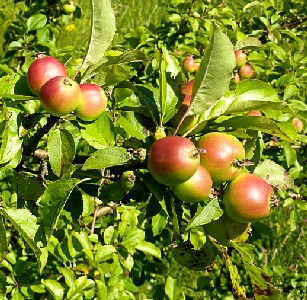
Photo: Wiki User Wehha - Crabapples (Malus Sylvestris)
Description: "Verjuse or Verjuce made of the juice of crabs [crabapples] is ...to be given in drinkes against burning fevers, it helpes well digestion, causeth appetite, relisheth well meates and drinkes [makes them taste good], and is cordiall, familiar, and pleasing to the taste; but it will not live above one yeare in good force at Sea, yet I give way to the putting it into the Surgeons chest, for that it is often desired by Surgeons."6
"Mali Sylvestris, Crabs. [Crabapples]
These are so extremely sour, and restringent upon the Palate, as not to be eaten raw; they are therefore us'd only for their express'd Juice, which serves in some Countries instead of Vinegar, and is much of the same Virtues. It is sold by the Name of Verjuice, and makes in many cases a very good Gargarism [gargle]."7
1 John Woodall, the surgions mate, 1617, p. 61; 2 "158. John Tweedy's Bill for Medicines. November 8, 1743". Privateering and Piracy in the Colonial Period Illustrative Documents, John Franklin Jameson, ed., p. 459; 3 Thomas Brugis, The Marrow of Physick, 1669, p. 165;4 Jean de Renou, A Medicinal Dispensatory, 1657, p. 371; 5,6 Woodall, p. 61; 7 John Quincy, Pharmacopoeia Officinalis & Extemporanea, 1719, p. 210
Zinziber (Ginger)
Listed in: Woodall: Zinziber1, Tweedy: Zinziber2
Category: Simple - Plant
Humoral Property: hot and dry in the third degree3; "hot [calefies] in the third degree4; "hot in the third degree"5
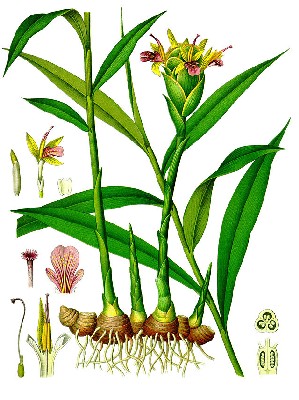
Artist: Franz Eugen Köhler
Ginger (Zingiber Officinale) (1897)
Description: "Zinziber, or Ginger ...helpeth concoction [digestion - combining of foods]: strengthneth a cold and weake stomacke: breaketh winde: and preventeth sowre eructation [sour belching]."6
"Ginger, in Latin Zinziber. It grows in all Provinces of India. 'Tis candied green in India, and it is good for Old People, and such as are cold and flegmatick [phlegmatic - having an abundance of the humor phlegm], and for such whose Stomachs do not concoct [digest food] well; especially when it is fresh candied. 'Tis also good for Viscid Flegm of the Lungs. The Indians use the Leaves of Ginger in Broths, and for the Kitchin. They also use the Roots of it green, with Oyl and Salt, mix'd with other Herbs. Fresh Ginger is reckon'd by them an excellent Remedy for Cholical Pains and for the Cæliack and Lientærick Passions [celiac passion and lientary are both a condition where food passes through the system only partially digested]. 'Tis also good for long Diarrhæa's, proceeding from Cold; and also for Wind, and the Gripes [pains in the stomach], and the like. But it is to be noted, that they who are of a hot Constitution ought not to use it, whether they are sick or well; for it inflames the Blood [blood is one of the 'hot' humors], and opens the Orifices of the Veins."7
Modern Uses: Ginger may be helpful for mild nausea and vomiting, although not for this when it is associated with chemotherapy. Note that this is not medical advice and the author is not a medical professional. Ginger can cause abdominal discomfort, heartburn, diarrhea, and mouth and throat irritation, especially if taken in large doses.8
1 John Woodall, the surgions mate, 1617, p. 104; 2 "158. John Tweedy's Bill for Medicines. November 8, 1743". Privateering and Piracy in the Colonial Period Illustrative Documents, John Franklin Jameson, ed., p. 460; 3 Nicholas Culpeper, Pharmacopœia Londinesis, 1720, p. 13; 4 Jean de Renou, A Medicinal Dispensatory, 1657, p. 271; 5,6 Woodall, p. 104;7 John Pechey, The Compleat Herbal of Physical Plants, 1707, p. 267; 8 Stephen Foster, "Ginger", www.nccih.nih.gov, gathered 2/17/23

